Jack Ross's Blog, page 9
October 29, 2022
What the Dickens?
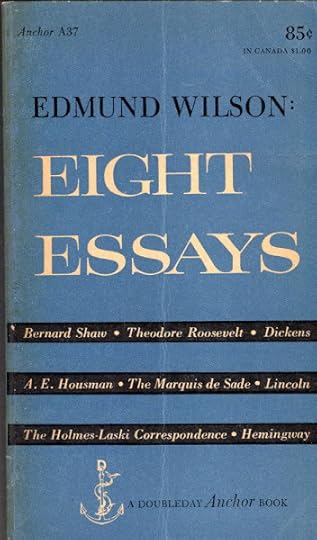 Edmund Wilson: Eight Essays (1954)
Edmund Wilson: Eight Essays (1954)Can All These Biographies be of the Same Man?
In his celebrated essay "The Two Scrooges," published in The New Republic in 1940, and subsequently collected in The Wound and the Bow (1941), American critic Edmund Wilson claimed to have detected a curious dichotomy in Charles Dickens's work. It is, according to Wilson:
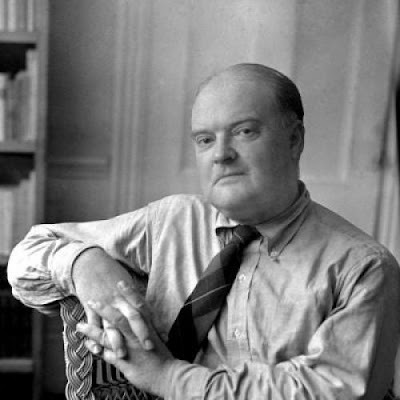 Edmund Wilson (1895-1972)
Edmund Wilson (1895-1972)organized according to a dualism which is based ... on the values of melodrama: there are bad people and there are good people, there are comics and there are characters played straight. The only complexity of which Dickens is capable is to make one of his noxious characters become wholesome, one of his clowns turn out to be a serious person. The most conspicuous example of this process is the reform of Mr. Dombey, who, as Taine says, “turns into the best of fathers and spoils a fine novel.”Earlier this year I posted a piece called "The World of Charles Dickens." In it I attempted to give a quick overview of my various collections of Dickens books, films and other ephemera (including jigsaw puzzles). But I only had space there to make a few references to the fascinating - and distinctly vexed - realm of Dickens biography. This is the brief summary I gave:
•
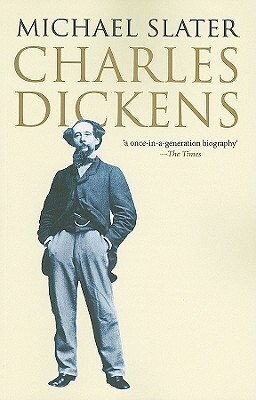 Michael Slater: Charles Dickens (2007)
Michael Slater: Charles Dickens (2007)There are many biographies. At times it can seem as if the majority even of bookish people are far less keen on reading him than reading about him. The original Victorian biography by John Forster is still an essential source, and I must confess, too, to a soft spot for Edgar Johnson's exhaustive two-volume account of 1952.Claire Tomalin: The Invisible Woman: The Story of Nelly Ternan and Charles Dickens (1990)
I'm not myself a great admirer of Peter Ackroyd's strange biography-with-fictional-interludes, though it certainly has its moments. A far more significant contribution to scholarship came from Claire Tomalin's The Invisible Woman: a biography of Dickens's mistress Nelly Ternan, which appeared in the same year, 1990.Claire Tomalin: Charles Dickens: A Life (2011)
She's followed this up since with a full-dress biography of Dickens, perhaps meant as a riposte to Michael Slater's, also pictured above. Slater is, after all, a bit of a Ternan-sceptic, witness his book The Great Charles Dickens Scandal (2012), which takes issue with many of Tomalin's points.
In any case, whatever your views on this or other contentious points, you won't find too much difficulty in finding material to your taste in the vast untidy field of Dickens scholarship. Even the famously critical Frank Leavis finally decided to admit him to the fold of the 'great tradition' in English fiction.
Ackroyd, Peter. Dickens' London: An Imaginative Vision. London: Headline Book Publishing PLC., 1987.Ackroyd, Peter. Dickens. London: Sinclair-Stevenson Ltd., 1990.Forster, John. The Life of Charles Dickens. With Thirty-Two Illustrations. 1872-74. London: Humphrey Milford / Oxford University Press, n.d.Johnson, Edgar. Charles Dickens. His Tragedy and Triumph. 2 vols. New York: Simon and Schuster Inc., 1952.Pope-Hennessy, Una. Charles Dickens: 1812-1870. 1945. London: The Reprint Society, 1947.Slater, Michael. Dickens and Women. 1983. London: J. M. Dent & Sons Ltd., 1986.Slater, Michael. Charles Dickens. 2009. New Haven, Connecticut: Yale University Press, 2011.Slater, Michael. The Great Charles Dickens Scandal. 2012. New Haven, Connecticut: Yale University Press, 2014.Tomalin, Claire. The Invisible Woman: The Story of Nelly Ternan and Charles Dickens. 1990. London: Penguin, 1991.Tomalin, Claire. Charles Dickens: A Life. 2011. London: Penguin, 2012.
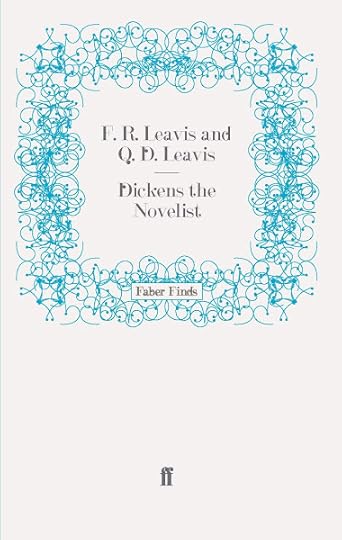 F. R. & Q. D. Leavis: Dickens the Novelist (1970)
F. R. & Q. D. Leavis: Dickens the Novelist (1970)•
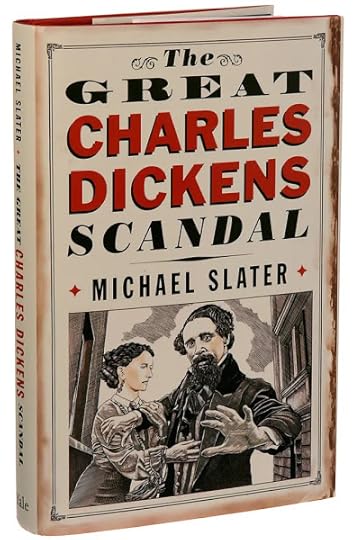 Michael Slater: The Great Charles Dickens Scandal (2012)
Michael Slater: The Great Charles Dickens Scandal (2012)Having now had time to think (and read) some more on the subject, I'd like to expand a bit on that rather bald account. Who exactly was Dickens? How is it possible for two biographies so thoroughly different as Michael Slater's (2007) and Claire Tomalin's (2011) to be published so hard on each other's heels?
It's not so much the protean nature of Dickens the man I mean to call into question: all of us are complex, contradictory, 'a million different people from one day to the next,' as the Verve's 1997 song "Bitter Sweet Symphony" so memorably puts it.
No, what interests me is the extent to which the 'Dickens' of these books resembles Wilson's analysis, quoted above, of the melodramatic assumptions underlying Dickens' own early work: "there are bad people and there are good people, there are comics and there are characters played straight."
 Claire Tomalin (b.1933)
Claire Tomalin (b.1933)Tomalin, it's true to say, does her best to maintain an even playing field. She begins her own biography with an inspiring anecdote about the lengths to which Dickens was prepared to go to help the poor and downtrodden, when - as a juror on a murder case - he fought tooth and nail for the acquittal and subsequent welfare of a young servant girl accused of killing her own child. Dickens, that is to say, as crusader. And you'd have to be pretty jaded not to be impressed by the sheer extent of Dickens' involvement in the case. He just wouldn't let it go. It was no momentary spasm of indignation on his part, but a lifelong commitment.
Unfortunately, in context, this story simply serves as a prelude to Tomalin's very persuasive portrait of Dickens as a tyrannical husband and neglectful papa - not to mention dastardly seducer. Edmund Wilson, too, highlights these traits, remarking that Dickens seems, at times, "almost as unstable as Dostoevsky."
He was capable of great hardness and cruelty, and not merely toward those whom he had cause to resent ... his treatment of Mrs. Dickens suggests, as we shall see, the behavior of a Renaissance monarch summarily consigning to a convent the wife who had served her turn. There is more of emotional reality behind Quilp in The Old Curiosity Shop than there is behind Little Nell. If Little Nell sounds bathetic today, Quilp has lost none of his fascination. He is ugly, malevolent, perverse; he delights in making mischief for its own sake; yet he exercises over the members of his household a power which is almost an attraction ... Though Quilp is ceaselessly tormenting his wife and browbeating the boy who works for him, they never attempt to escape: they admire him; in a sense they love him.For Wilson, Dickens' work as a whole is a haunted palace, full of neglected corridors leading to unspeakable secrets: the very epitome of Gothic melodrama. And he wrote like that because that's how he lived:
Dickens’ daughter, Kate Perugini, who had destroyed a memoir of her father that she had written, because it gave “only half the truth,” told Miss Gladys Storey, the author of Dickens and Daughter, that the spell which Dickens had been able to cast on his daughters was so strong that, after his separation from their mother, they refrained, though he never spoke to them about it, from going to see her, because they knew he did not like it ... “I loved my father,” Miss Storey reports her as saying, “better than any man in the world — in a different way of course. … I loved him for his faults.” And she added, as she rose and walked to the door: “My father was a wicked man — a very wicked man.” But from the memoir of his other daughter Mamie, who also adored her father and seems to have viewed him uncritically, we hear of his colossal Christmas parties, of the vitality, the imaginative exhilaration, which swept all the guests along.Like Scrooge himself, the ostensible subject of Wilson's essay, Dickens sounds like "the victim of a manic-depressive cycle, and a very uncomfortable person."
How, then, does Michael Slater deal with all this, in his own comprehensive biography of the author?
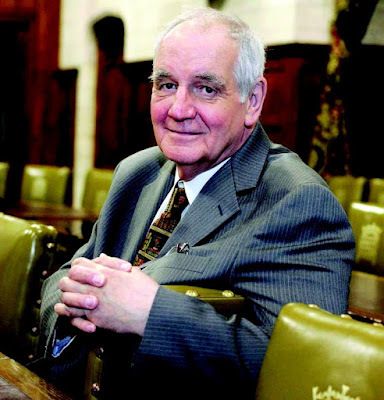 Michael Slater (b.1936)
Michael Slater (b.1936)Well, for the most part he ignores it, that's how. From the very first pages of his biography, he makes it clear that it's only really Dickens the Victorian man-of-letters who interests him, and whom he feels qualified to write about.
Professor Slater comments in great detail on the idea of serial publication, pioneered in The Pickwick Papers, and then carried on via a variety of vehicles: the monthly numbers used for such novels as Oliver Twist, Nicholas Nickleby, and their various successors; but also the succession of weekly periodicals Dickens edited, among them Master Humphrey's Clock (1840-41), home of The Old Curiosity Shop; Household Words (1850-59), where he published Hard Times and A Child's History of England; and, finally, All the Year Round (1859-90), which eventually housed A Tale of Two Cities, Great Expectations, and The Uncommercial Traveller.
That's just the beginning for Slater, though. Amateur theatricals, occasional journalism, travel books, editing jobs such as the great clown Grimaldi's memoirs - all are woven together into a marvellous tapesty of mid-Victorian cultural life. His four-volume annotated edition of Dickens's collected journalism stands him in good stead when it comes to documenting and - above all - making sense of this mountain of circumstantial detail.
This is his crucial break with what might be called the Wilsonian tradition of Freudian (or at least psychoanalytical) criticism, as it's been applied to Dickens since the appearance of "The Two Scrooges" in the 1940s. The first biographer to employ these insights, albeit sparingly, was probably Una Pope-Hennessy in her wonderfully compact Charles Dickens: 1812-1870 (1945).
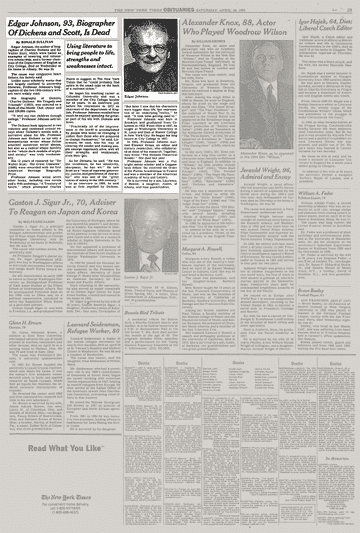 Edgar Johnson (1902-1995)
Edgar Johnson (1902-1995)The major monument to this tradition would, however, have to be Edgar Johnson's exhaustive two-volume critical biography Charles Dickens: His Tragedy and Triumph (1952). Johnson's "life and times" approach - which he applied again, a couple of decades later, to his similarly vast biography of Sir Walter Scott, The Great Unknown (1970) - has been found offputting by some (Peter Ackroyd principal among them). For myself, I love it.
I can see the advantages of focussing principally on Dickens's emotional life, as Tomalin does, or his professional life, as Slater does, but Johnson's system of alternating chapters of pure biography with chapters of analysis of each of Dickens's major works is surprisingly successful. Certainly one emerges from such a reading with a vivid knowledge of each of the novels as well as the minutiae of the novelist's life.
In Slater's terms, Johnson is a 'believer' - one who accepts that Nelly Ternan was Dickens's mistress, and that their relationship was almost certainly a sexual one. So is Pope-Hennessy. And Tomalin, of course, is the high priest of this tradition. Peter Ackroyd, whom I'll come to in a minute, is on the fence. He accepts the evidence of Ternan's importance in Dickens' life, but finds it unlikely that their relationship was ever consummated: his Dickens is far too weird for that. Michael Slater, of course, is the leader of the Denialist school who insists - quite correctly - on the extreme flimsiness of the evidence so far produced for the actual existence of this relationship.
Eppur si muove would be my own conclusion on this vexed matter, thrashed out so thoroughly in so many books over the last century or so. That's what Galileo is alleged to have said as he emerged from the Church tribunal which had just forbidden him to assert as fact the Earth's progress around the Sun: "but it does move, anyway." I just can't bring myself to believe that the whole affair is based on moonshine and a few misunderstood letters. It was too big a scandal to suppress at the time, and salutary though Slater's subsequent attempts to point out the deficiencies of the opposition's case have been, I fear that I would have to award the victory to Tomalin on this one, on points.
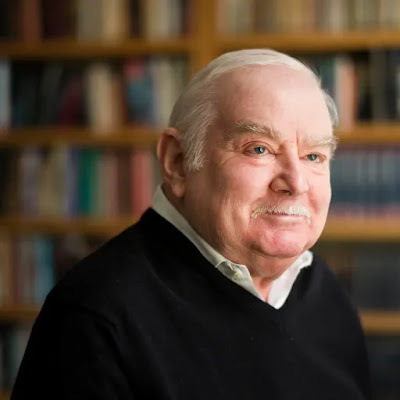 Peter Ackroyd (b.1949)
Peter Ackroyd (b.1949)Which brings us to undoubtedly the strangest of all of the modern biographies, Peter Ackroyd's Dickens (1990). Ackroyd's decision to incorporate fictional 'episodes', evocative dreamscapes a little reminiscent of some of De Quincey's opium visions, caused a great deal of comment at the time. Whether or not it's effective, it's certainly different - and while these sections co-exist rather oddly with the rest of his heavily researched text, it can't simply be written off as a failure. There's something in it, though it's not quite clear (to me, at least) just what.
Ackroyd's main innovation as a biographer, though, was his heavy dependence on the backfiles of The Dickensian, the Dickens-enthusiasts' journal which has been charting every minute detail of the Master's work since 1905. This immense heap of articles provided him with ammunition for his demolition of the Johnsonian life-and-times approach. Johnson's research turns out to have been largely library-based, whereas Ackroyd is able to explore both the texts and the landscapes through the eyes of legions of fanatical (and, for the most part, footsore) contributors to The Dickensian.
This does impart a curiously patchwork tone to Ackroyd's text, but given his devotion to psychogeography as a discipline, it also serves to highlight the strange interfusion he posits between Dickens and London, the city that defined him both as an author and a man, expanding in this on his earlier picture book Dickens' London: An Imaginative Vision.
Ackroyd was, however, somewhat handicapped by the fact that the magisterial Pilgrim edition of Dickens' complete letters (12 vols, 1965-2002) was not yet complete while he was writing. All subsequent biographies and scholarship on Dickens have been dominated by this massive piece of research, entailing, as it did, an exact charting of his doings on virtually every day of his adult life. Like his predecessors Pope-Hennessy and Johnson, Ackroyd was still forced to resort at times to the woefully incomplete Nonesuch edition of Dicken's correspondence (3 vols, 1938).
 Charles Edward Perugini: John Forster (1812-1876)
Charles Edward Perugini: John Forster (1812-1876)Might it be said, in fact, that we know a bit too much about Dickens nowadays? The dichotomy between Slater and Tomalin's work seems a bit less surprising when you factor in the sheer weight of material at a modern biographer's fingertips: as well as those 12 volumes of letters, and the serried rows of back-issues of the Dickensian, there are books and articles on virtually every aspect of his life. One must, in other words, be selective: especially if you're trying desperately to cram your conclusions into a single manageable volume.
Which brings me to the great-grandaddy of all Dickens biographies, John Forster's Life of Charles Dickens (3 vols, 1872-74). Forster was a close friend of Dickens, and supported and counselled him at all stages of his professional life - not always successfully. He was also an accomplished biographer and man of letters in his own right, author of Oliver Goldsmith: His Life and Times (1848) as well as a life of the poet Walter Savage Landor (1868) - reputedly the original for the character Boythorne in Bleak House.
 Lytton Strachey: The Illustrated Eminent Victorians (1989)
Lytton Strachey: The Illustrated Eminent Victorians (1989)Ever since Lytton Strachey did his demolition job on Victorian biographies in Eminent Victorians (1918), there's been a reaction against those respectable, four-square, generally multi-volumed Life and Letters which used to be the mainstay of every library. Many modern readers have got out of the habit of reading them at all, assuming that all the interesting stuff will have been edited out of them according to the wishes of the family, and that what is left will be, at best, the record of a whited sepuchre.
I haven't found it to be so. Forster's biography of Dickens is a masterpiece: famously revelatory of the sufferings of his early boyhood, but wonderfully vivid at every turn. It reads, in fact, like a Victorian three-decker - though probably not one of Dickens' own: more like a novel by Trollope or Thackeray. Often he says things so well that, given the fact that he was also saying them for the first time, there was not a lot to be added to his account subsequently.
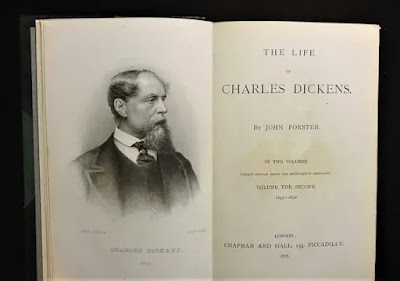 John Forster: Life of Charles Dickens (1872-74)
John Forster: Life of Charles Dickens (1872-74)If I had to recommend one biography of Dickens, I'd probably recommend Forster's. For myself, I have an abiding love for Edgard Johnson's, but it is very long, and the abridged one-volume version (which is probably the one most people read) doesn't really do justice to his overall concept.
I once met Professor Michael Slater. It was at a conference at Auckland University, some 25 years ago. He gave a wonderful paper on Douglas Jerrold, and proved to be the gentlest, sunniest, kindest gentleman I think I've ever encountered at such an event. There was not the slightest self-vaunting or sidiness about him, though he was certainly keen to expound the merits of the new edition of Dickens's journalism he was then working on. I'm predisposed in his favour, in other words.
If you're interested mainly in Dickens as a writer, then Slater is the biographer for you. His book is tough going at times, but he keeps all the balls in the air with marvellous dexterity, and the painfully accumulated detail all comes home to roost if you're prepared to persevere.
If you're interested - in Wilsonian style - in the tormented genius behind the books, then Tomalin's biography will suit you much better. It's a more mature book in every way than The Invisible Woman - fascinating though the earlier book was, that particular job only needed to be done once. Tomalin bends over backwards to try to understand Dickens' point of view, but he was just a very difficult man to like - unless you were prepared just to sit back and enjoy the show, as so many of his friends and acquaintances were. His family and his business associates did not have that option, unfortunately.
But do any of these books really get us much closer to Dickens himself? You can end up knowing more raw information about him than you know about any other human being you ever met, and still be struck by how mysterious he seems. His innermost personality - even the most important details of his emotional life - seems, in the end (as the poet said of Robert E. Lee), secure from "the picklocks of biographers":
For he will smile
And give you, with unflinching courtesy,
Prayers, trappings, letters, uniforms and orders,
Photographs, kindness, valor and advice,
And do it with such grace and gentleness
That you will know you have the whole of him
Pinned down, mapped out, easy to understand —
And so you have.
All things except the heart.
...
For here was someone who lived all his life
In the most fierce and open light of the sun,
Wrote letters freely, did not guard his speech,
Listened and talked with every sort of man,
And kept his heart a secret to the end
From all the picklocks of biographers.
Stephen Vincent Benét: from 'Robert E. Lee' (1928)
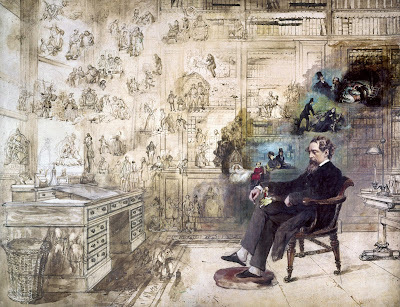 Robert William Buss: Dickens's Dream (1875)
Robert William Buss: Dickens's Dream (1875)
Published on October 29, 2022 12:46
September 24, 2022
Time Travel and Beyond
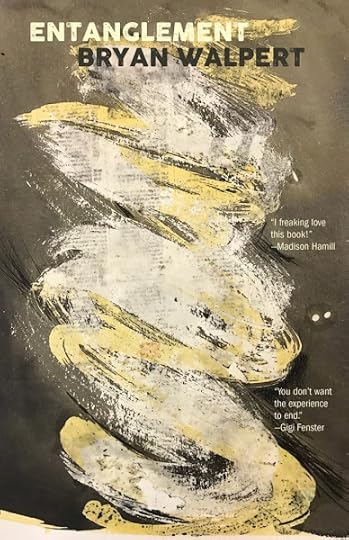 Bryan Walpert: Entanglement (2021)
Bryan Walpert: Entanglement (2021)Time Travel and Beyond
Is time travel possible? Why write another novel about it?
Jack Ross chats with Bryan Walpert, Devonport resident and author of the 2022 Ockham short-listed novel Entanglement, about time travel, the challenge of putting science into a novel, crossing the border from poetry to fiction, science fiction vs. science-in-fiction, and more.
Books will be available for purchase.

•
As a researcher [at the Centre for Time at the University of Sydney] was settling me into my cubicle, he gave me some advice: Don’t think about it too hard and you’ll know what time it is; think about it too much and you’ll confuse yourself. As it turns out, this more or less describes our relationship with time as expressed by St Augustine some 1800 years ago. He wrote, “What then is time? If no one asks me, I know what it is. If I wish to explain it to him who asks, I do not know.”Luckily for me, Bryan has already given us some pretty strong clues about how to interpret his novel Entanglement. In particular, the notion of whether or not the past and future are 'really' there is canvassed quite extensively:
Somewhat stranger than this, to me at least, is the question of how real the past and future are. Most of us have an intuitive sense that events in the past (e.g. the French Revolution) are no longer happening and that the future doesn’t exist until we, well, get there ... This corresponds with what has been called the “tensed” theory of time or “presentism.” But there are also proponents of what’s called the “block universe” or sometimes “eternalism.” By that way of thinking, the past, present and future all exist.His Newsroom article on the subject even gives us the moment of inception of the book:
When I’m asked what led me to write Entanglement, I recall the moment some years ago that inspired it. It was a summer’s day. I was standing just outside my house, my family waiting for me inside, and felt, suddenly, as though I’d come back from the future, some darker time — though what the future was I didn’t know. My kids are so young again, I remember thinking. My wife and I are amazingly young, too.If you'd like to hear more about these weighty matters, please come along to the Devonport Library this coming Tuesday to listen to me and Bryan discussing his fascinating novel and the myriad questions it poses.
I felt like I had been given another chance. I thought, There are so many mistakes I hadn’t yet made. It was a strange and powerful feeling, though it didn’t last — the moment passed. Or maybe the moment is still and eternally there in its little corner of the block universe ...
– Bryan Walpert, ‘Is time travel possible? Yes-ish’ Newsroom (3/3/22)
Once again, this event has been made possible by the Devonport Library Associates: chair Jan Mason, events organiser Paul Beachman, and publicity courtesy of Linda Hopkins.
•
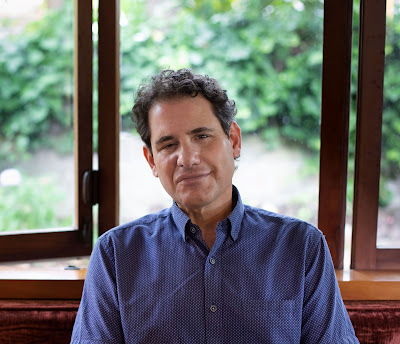 Bryan Walpert
Bryan Walpert
Bryan Walpert is the author of four books of poems, most recently Brass Band to Follow (Otago UP), named among the top 10 poetry collections of 2021 by the NZ Listener. He is also the author of three books of fiction, including the novel Entanglement, short-listed for the Jann Medlicott Acorn Prize for Fiction at the 2022 Ockham New Zealand Book Awards. A Devonport resident, he is a Professor of Creative Writing at Massey University-Albany.
•
 Te Pātaka Kōrero o Te Hau Kapua / Devonport Library
Te Pātaka Kōrero o Te Hau Kapua / Devonport Library•
Published on September 24, 2022 13:32
September 11, 2022
Breaking the Maya Code
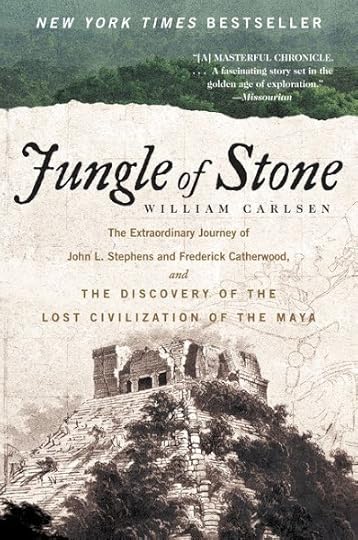 William Carlsen: Jungle of Stone (2016)
William Carlsen: Jungle of Stone (2016)William Carlsen. Jungle of Stone: The Extraordinary Journey of John L. Stephens & Frederick Catherwood, and the Discovery of the Lost Civilisation of the Maya. 2016. William Morrow. New York: HarperCollins Publishers, Inc., 2017.
The other day I was in a Hospice shop where I ran across a copy of the book above, priced at the princely sum of $4. I promptly bought it, of course, mainly because the blurb proclaimed it to be in the 'tradition of Lost City of Z and In the Kingdom of Ice'.
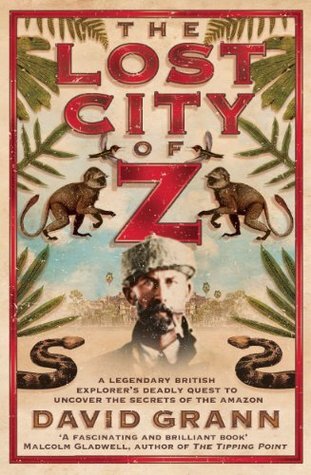 David Grann: The Lost City of Z: A Tale of Deadly Obsession in the Amazon (2009)
David Grann: The Lost City of Z: A Tale of Deadly Obsession in the Amazon (2009)The first of those two I'm only too familiar with, having both read the book and watched the weirdly entertaining movie, starring Charlie Hunnam as the intrepid (if somewhat misguided) Colonel Percy Fawcett, who disappeared in the Amazon jungle in 1925 and has never been seen since.
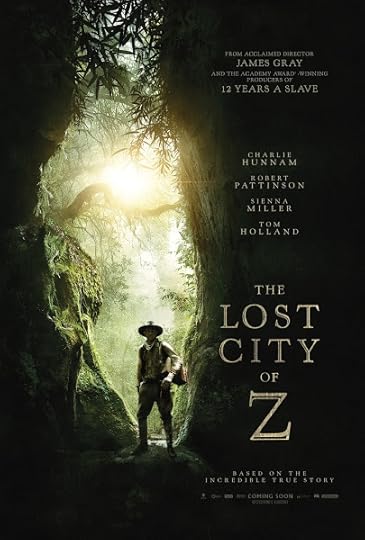 James Gray, dir.: The Lost City of Z (2016)
James Gray, dir.: The Lost City of Z (2016)I'd never heard of the second one, but it sounds very much like my kind of thing, and I'll certainly be on the lookout for a second-hand copy of it next time I'm out on the prowl:
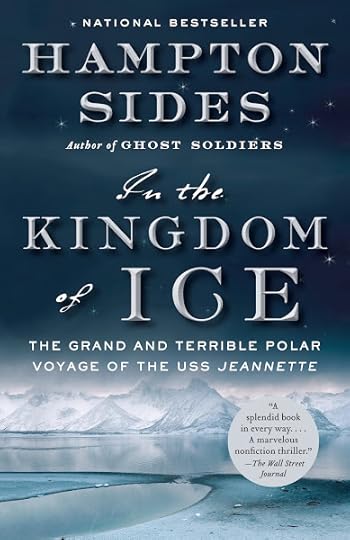 Hampton Sides: In the Kingdom of Ice: The Grand and Terrible Polar Voyage of the USS Jeannette (2014)
Hampton Sides: In the Kingdom of Ice: The Grand and Terrible Polar Voyage of the USS Jeannette (2014)The superior attractions of Jungle of Stone, however, come both from its setting and its subject matter.
I'm rather a fan of books about the mysterious Mayan civilisation, as anyone motivated enough to have looked through my 2019 collection Ghost Stories will attest. The story 'Leaves from a Diary of the End of the World' begins with the following - lightly fictionalised - account of a not dissimilar windfall almost exactly ten years ago now:
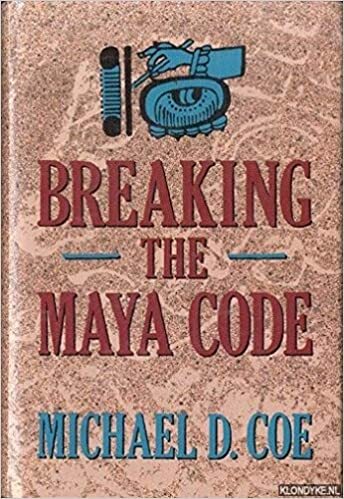 Michael Coe: Breaking the Maya Code (1992)
Michael Coe: Breaking the Maya Code (1992)
Tuesday, 21 February, 2012:
Today I found an old book in the library, in the de-accessioned pile. It cost me two dollars to buy it (Hardback Non-fiction – if it had been Fiction, it would only have been a dollar). The title was Breaking the Maya Code, by Michael Coe.
But why on earth were they throwing it out?
It’s true that this was a copy of the first, 1992, edition, and since then – I checked – Coe has gone on to publish a number of revisions of his book (just as he did with his 1966 text The Maya, now in its eighth edition). So perhaps they thought it was too out of date to be useful.
What I suspect, though, is that they read those words ‘the Maya Code’ as something analogous to the Da Vinci Code – as a reference to the (alleged) Mayan Prediction of the end of days in December 2012.
If so, they were sorely mistaken. Far from an Occultist text full of babble about the Apocalypse, Coe’s is a profoundly scholarly work, which tells the tale of one of the greatest decipherments of all time.
The name of Yuri Valentinovich Knorosov, the Russian genius whose phonological and comparative methodology finally led to success in this two-hundred-year-old quest, should undoubtedly go down in history along with Jean-François Champollion, Michael Ventris, and other heroes of the intellect.
The fact that we can now actually read these texts from a far-off civilisation, mute for centuries, thanks solely to such feats of ingenuity is one of the few proofs I know that the cosmos is not entirely arbitrary.
Just as the patterns of Nature become clear over time when examined by the dispassionate intellect, so advances can be made in our knowledge, the stones can be made to speak.
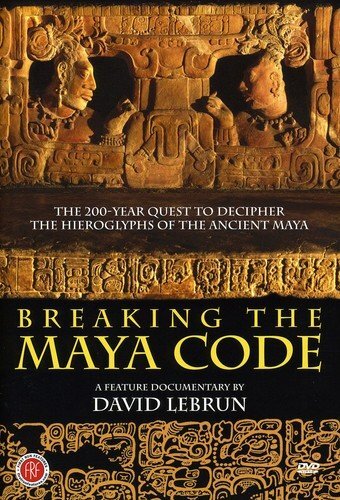 David Lebrun, dir.: Breaking the Maya Code (2008)
David Lebrun, dir.: Breaking the Maya Code (2008)In fact, I subsequently went to the extra trouble of ordering a copy of a two-hour documentary on the subject, which I greatly recommend to anyone curious about just how precisely one goes about decoding an unknown script in an archaic version of an admittedly still living (though very complex) language.
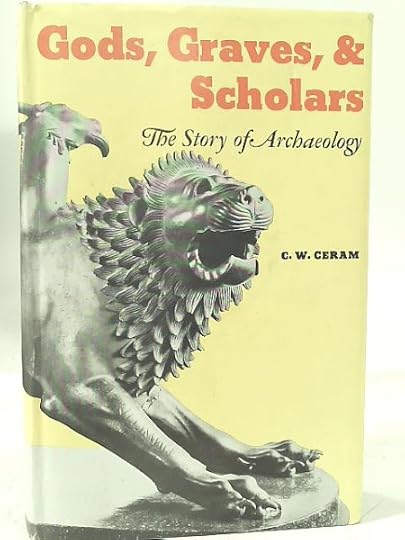 C. W. Ceram: Gods, Graves and Scholars: The Story of Archaeology (1949 / 1951)
C. W. Ceram: Gods, Graves and Scholars: The Story of Archaeology (1949 / 1951)When it comes to Stephens and Catherwood, I did already know the rough outline of their story from early reading and rereading of the wonderfully exciting - to a nerdy teenager, at any rate - Gods, Graves and Scholars, by German journalist Kurt Wilhelm Marek (who published under the pseudonym 'C. W. Ceram').
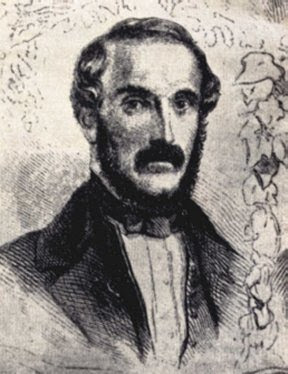 John L. Stephens (1805–1852)
John L. Stephens (1805–1852)I've written elsewhere about my interest in 19th-century American Historians such as Washington Irving, Francis Parkman and William H. Prescott, who were among the very first authors from the Western hemisphere to attract a substantial Old World audience. John Lloyd Stephens certainly has to be counted among their number.
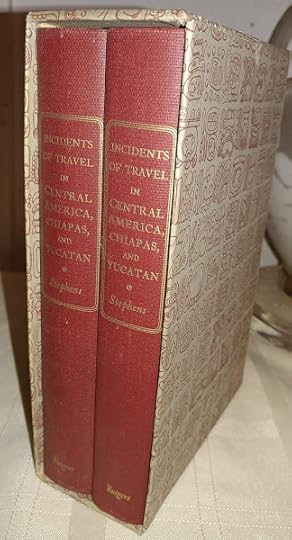 John L. Stephens: Incidents of Travel in Central America, Chiapas, & Yucatán (1841 / 1949)
John L. Stephens: Incidents of Travel in Central America, Chiapas, & Yucatán (1841 / 1949)John L. Stephens. Incidents of Travel in Egypt, Arabia Petraea, and The Holy Land. 1837. Ed. Victor Wolfgang von Hagen. Illustrated by Frederick Catherwood. 1970. San Francisco: Chronicle Books, 1991.John L. Stephens. Incidents of Travel in Central America, Chiapas, & Yucatán. Illustrated by F. Catherwood. 1841. Ed. Richard L. Prodmore. 2 vols. New Brunswick: Rutgers University Press, 1949.John L. Stephens. Incidents of Travel in Yucatán. Illustrated by F. Catherwood. 2 vols. 1843. New York: Dover Publications, Inc., 1963.
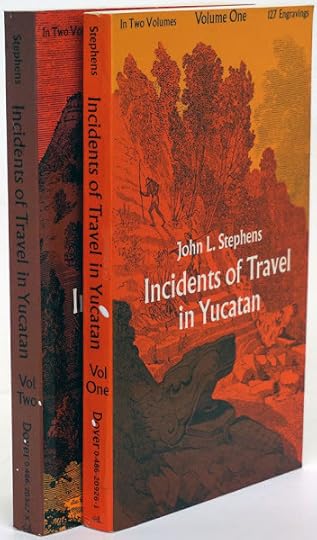 John L. Stephens: Incidents of Travel in Yucatán (1843 / 1963)
John L. Stephens: Incidents of Travel in Yucatán (1843 / 1963)It's fair to say, though, that Stephens' two classic books about his rediscovery of the lost Mayan cities - both of which I own (and, more to the point, have read from cover to cover) - would never have known such immediate success it weren't for the work of his collaborator and illustrator, itinerant Englishman Frederick Catherwood.
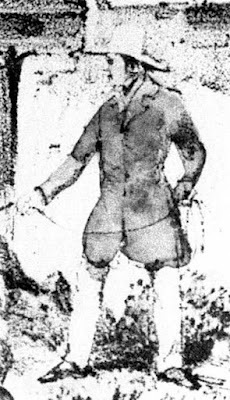 Frederick Catherwood (1799-1854)
Frederick Catherwood (1799-1854)It was Catherwood whose immensely detailed and accurate sketches of Mayan inscriptions, ruins, and sculptures established beyond dispute the artistic merits of this long-vanished civilisation. Even now it's hard to imagine how they could be surpassed:
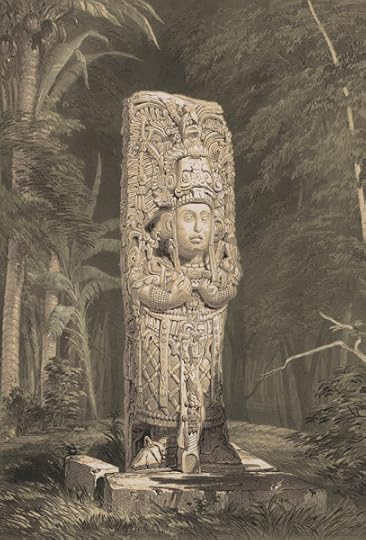 Frederick Catherwood: Stela at Copan, from Views of Ancient Monuments (1844)
Frederick Catherwood: Stela at Copan, from Views of Ancient Monuments (1844)Stephens was an exceptionally able journalist, who told a rattling good yarn. When he wasn't being threatened with instant death by murderous soldiers, he was being laid low by tropical diseases. Somehow he managed to keep going, though, despite the lawlessness of much of Central America at the time.
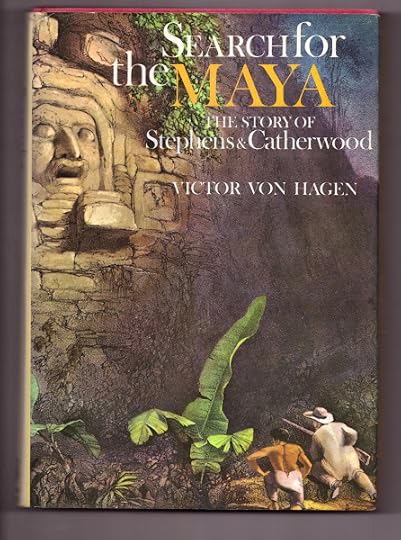 Victor von Hagen: Search for the Maya: The Story of Stephens and Catherwood (1973)
Victor von Hagen: Search for the Maya: The Story of Stephens and Catherwood (1973)It's really Catherwood one sympathises with most, however. He was often left behind at some inaccessible site to complete his sketches of the ruins while Stephens went off on some more glamorous (albeit even more dangerous) errand. Working, at times, up his ankles in mud, with jungle undergrowth obscuring his view, Catherwood used his camera lucida apparatus to trace each inscription and statue as carefully as he could.
Despite not knowing the meanings of any of the symbols he recorded, he drew them so carefully that many of his drawings are still used by Mayan scholars in preference to the original walls and statues, now further perished by time.
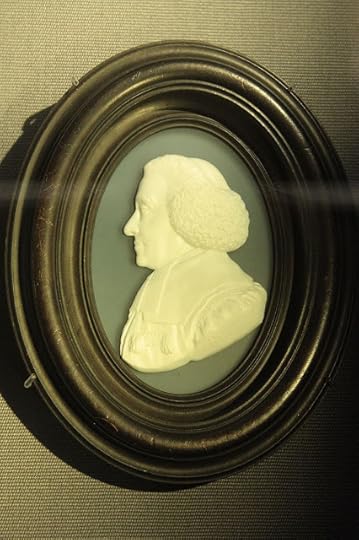
William Robertson (1721-1793)
Stephens and Catherwood were by no means the first to see these immense ruins, but they were certainly the most assiduous in recording and disseminating the wonders they'd found.
Thanks to the influence of sceptical British historians such as William Robertson, whose History of America (1777) threw considerable doubt on the existence of the architectural and artistic marvels described by the original Conquistadors, most people at the time still assumed that there had never been a civilisation in the Americas to rival those of Egypt and Mesopotamia. The dogmatic Scots clergyman stated it baldly:
The inhabitants of the New World were in a state of society so extremely rude as to be unacquainted with those arts which are the first essays of human ingenuity on its advance toward improvement.Their temples, he went on to stress, could have been little more than 'a mound of earth' and their houses 'mere huts, built with turf, or mud, or the branches of trees, like those of the rudest Indians.' 'There is not', he concluded:
in all the extent of that vast empire, a single monument or vestige of any building more ancient than the conquest.Robertson based this blanket dismissal of all the innumerable detailed chronicles of the Spanish conquest - by Cortés, Pizarro, and their many contemporaries - on the account of one informant who had (allegedly) 'travelled in every part of New Spain.'
Both Stephens and Catherwood had, however, travelled widely in the Middle East as well as the Americas, and it was apparent to them that the creators of cities such as Copán, Tikal, and Chichen Itza, were in no way inferior to Ancient Greeks and Romans when it came to urban planning. They had been, in fact, in many ways more culturally advanced than their classical contemporaries.
As Stephens himself put it, in the conclusion to Incidents of Travel in Central America, Chiapas, & Yucatán, 'The monuments and pyramids of Central America and Mexico are':
different from the works of any other known people, of a new order, and entirely and absolutely anomalous: they stand alone. ...What a resounding declaration of American intellectual independence! No wonder the book was an instant success. Even the notoriously picky Edgar Allan Poe hailed it as 'magnificent ... perhaps the most interesting book of travel ever published'.
Unless I am wrong, we have a conclusion far more interesting and wonderful than that of connecting the builders of these cities with the Egyptians or any other people. It is the spectacle of a people skilled in architecture, sculpture and drawing, and, beyond doubt, other more perishable arts, and possessing the culture and refinement attendant upon these, not derived from the Old World, but originating and growing up here, without models or masters, having a distinct, separate, independent existence; like the plants and fruits of the soil, indigenous.
•
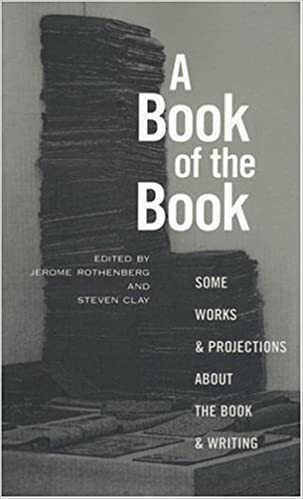 A Book of the Book (2000)
A Book of the Book (2000)Thanks to the work of contemporary scholars and translators such as Michael Coe, Sylvanus Morley, and Denis Tedlock, we can now read the creation epic of the Mayans, the Popol Vuh, in a variety of versions.
As well as the wonders of their advanced mathematical knowledge and wonderfully subtle script, Tedlock's essay 'Towards a Poetics of Polyphony and Translatability' - from the anthology pictured above, A Book of the Book: Some Works & Projections about the Book & Writing (2000) - demonstrates the complex nature of Mayan poetics, in particular the habit of Mayan writers of constantly rephrasing and paraphrasing their meanings, rather than treating poems "as if they were Scripture, composed of precisely the right words and no others':
In a poetics that always stands ready, once something has been said, to find other ways to say it, there can be no fetishization of verbatim quotation, which lies at the very heart of the Western commodification of words. In the Mayan case not even writing, whether in the Mayan script or the Roman alphabet, carries with it a need for exact quotation. When Mayan authors cite previous texts, and even when they cite earlier passages in the same text, they unfailingly construct paraphrases. [266-67]The implications of this tendency are extremely far-reaching, particularly when it comes to translation:
Translation caused anxiety long before the current critique of representations, especially the translation of poetry. Roman Jakobson pointed the way to a new construction of this problem, suggesting that the process of rewording might be called intralingual translation ...The conclusion of Tedlock's essay refuses to draw the conventional distinctions between the poetics and politics of the word, just as the Mayan poets he cites see no need to differentiate between quotation and paraphrase:
Here we have entered a realm in which the popular notion of an enmity between poetry and translation does not apply. To quote Robert Frost's famous phrasing of this notion ... 'Poetry is what gets lost in translation.' ... [Octavio] Paz countered by saying 'Poetry is what is translated.' ... To take this statement a step further and paraphrase it for the purposes of the present discussion, poetry is translation. [267-68]
we could try to see the complexity of Mayan poetry as the result of a conflict between centripetal forces in language, which are supposed to produce formal and authoritative discourse, and centrifugal forces, which are supposed to open language to its changing contexts and foment new kinds of discourse. But this is a profoundly Western way of stating the problem. Available to speakers of any language are multiple systems for phrasing utterances, including syntax, semantics, intonation, and pausing. Available to writers (even within the limits of a keyboard) is a variety of signs, of which some are highly individual and particulate while others are iconic and may stand for whole words. There is nothing intrinsic to any one of these various spoken and written codes, not even the alphabet itself, that demands the reduction of all or any of the others to its own terms. Bringing multiple codes into agreement with one another is not a matter of poetics as such, but of centralized authority [my emphasis]. It is no accident that Mayans, who never formed a conquest state and have kept their distance from European versions of the state right down to the current morning news, do not bend their poetic energies to making systems stack. [276]
•
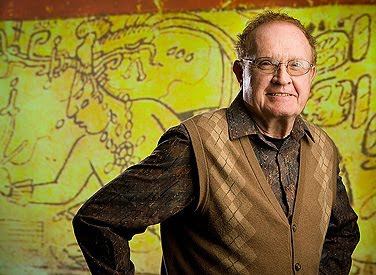
Dennis Tedlock (1939- )
Mayan Literature in Translation
Coe, Michael D. The Maya. 1966. Eighth edition, fully revised and expanded. Ancient People and Places: Founding Editor Glyn Daniel. London: Thames & Hudson Ltd., 2011.
Coe, Michael D. Mexico: From the Olmecs to the Aztecs. 1962. Fourth edition, fully revised and expanded. 1994. Ancient People and Places: Founding Editor Glyn Daniel. London: Thames & Hudson Ltd., 1997.
Recinos, Adrián, ed. Popol Vuh: The Sacred Book of the Ancient Quiché Maya. 1947. Trans. Delia Goetz & Sylvanus G. Morley. London: William Hodge & Company Limited, 1951.
Saravia E., Albertina, ed. Popol Wuj: Antiguas Historias de los Indios Quiches de Guatemala. Illustradas con dibujos de los Codices Mayas. 1965. “Sepan Cuantos …”, 36. Ciudad de México: Editorial Porrúa, S. A., 1986.
Sodi M., Demetrio. La literatura de los Mayas. 1964. El Legado de la América Indígena. México: Editorial Joaquín Mortiz, S. A., 1974.
Tedlock, Dennis, trans. Popol Vuh: The Definitive Edition of The Mayan Book of The Dawn of Life and The Glories of Gods and Kings. With Commentary Based on the Ancient Knowledge of the Modern Quiché Maya. 1985. Rev. ed. A Touchstone Book. New York: Simon & Schuster Inc., 1996.
Tedlock, Dennis. 2000 Years of Mayan Literature: With New Translations and Interpretations by the Author. Berkeley & Los Angeles: University of California Press, 2010.
Published on September 11, 2022 14:52
August 28, 2022
Sir John Lubbock's 100 Books
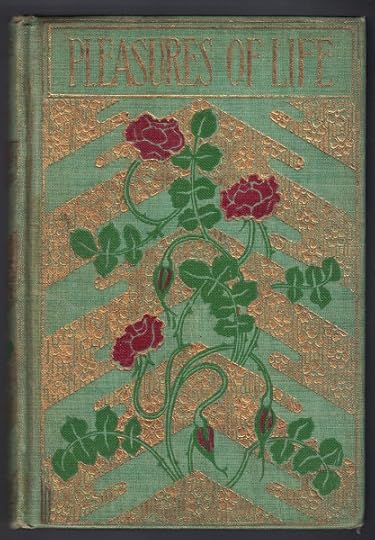 Sir John Lubbock: The Pleasures of Life (1887)
Sir John Lubbock: The Pleasures of Life (1887)One fateful evening in 1886, the Principal of the London Working-Men’s College, Sir John Lubbock, gave a speech to that institution. In it he outlined a list of 100 vital books which, if read attentively, might in themselves constitute a liberal education.
The idea took off with a vengeance, and after the list was reprinted in his essay-collection The Pleasures of Life, earnest self-improvers everywhere started to collect the various volumes.
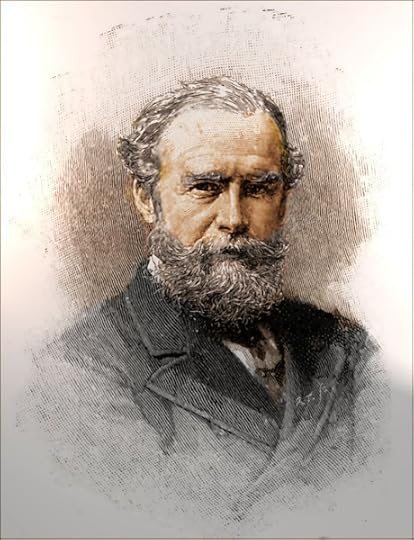 Sir John Lubbock (1834-1913)
Sir John Lubbock (1834-1913)Lubbock himself never attended university, though he came from a privileged background, and had been educated at Eton by his wealthy family. A banker by profession, his real passions were archaeology and evolutionary biology, and he wrote extensively on both subjects.
Amongst other achievements, he was the the first to coin the terms "Neolithic" and "Palaeolithic" in one of his books about early man.
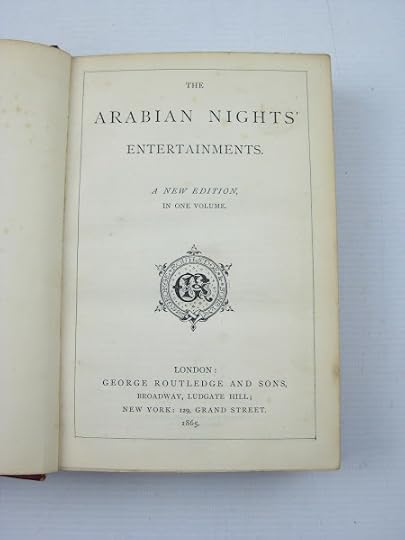 Antoine Galland: The Arabian Nights' Entertainments (London: Routledge, 1865)
Antoine Galland: The Arabian Nights' Entertainments (London: Routledge, 1865)The very first copy of the Arabian Nights I ever owned (rather similar to the one pictured above, but more battered and dogeared) proudly proclaimed itself as one of these "hundred books" - which gives some clue to the bonanza this must have constituted for enterprising publishers in the late nineteenth century.
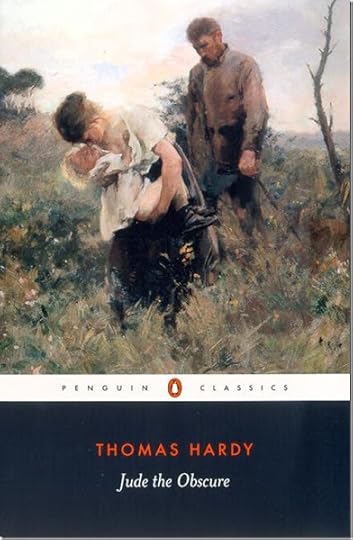 Thomas Hardy: Jude the Obscure (1894-95)
Thomas Hardy: Jude the Obscure (1894-95)It's easy to see how this idea of self-betterment through focussed reading informs Hardy's last prose masterpiece Jude the Obscure, with its almost unbearably poignant account of rural autodidact Jude's attempts to enter the sheltered cloisters of Christminster University through sheer effort and application. All in vain, of course (it is, after all, a Thomas Hardy novel).
There's a particularly poignant scene where Jude is sitting miserably by the side of the road realising the folly of his grand ambitions, and longing for someone to come by and comfort him:
But nobody did come, because nobody does: and under the crushing recognition of his gigantic error Jude continued to wish himself out of the world. - Jude the Obscure (1895)
•
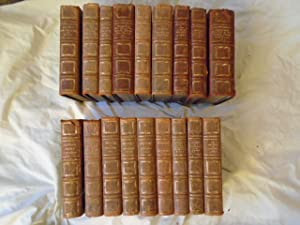 18 of the 100 Books (London: Routledge, 1890)
18 of the 100 Books (London: Routledge, 1890)[The Shi King of Confucius; The Iliad and Odyssey of Homer; Darwin's Journal of Discoveries; The Origin of Species; The History of the Decline and Fall of the Roman Empire I and II; Adam Smith's Wealth of Nations; Captain Cook's Voyages; Humboldt's Travels I-III; Scott's Ivanhoe; La Morte D'Arthur; Spinoza; The Arabian Nights' Entertainments; Bacon's Novum Organum; The Nibelungenleid; Thackeray's Pendennis]
Here, in any case, is a slightly tidied-up list of the original 100 books. It's rather hard to make the numbers fit consistently, given Lubbock's habit of listing multiple works under one author or, alternatively, listing separate works by a writer under different categories. He also published different versions of it at different times.
Each entry has been linked to a free online text wherever possible.
LIST OF 100 BOOKS
[Works by Living Authors are omitted]
The Holy BibleThe Meditations of Marcus AureliusEpictetusAristotle’s EthicsThe Analects of ConfuciusSt Hilaire’s Le Bouddha et sa religionWake’s Apostolic FathersThomas à Kempis’ Imitation of ChristConfessions of St. AugustineThe KoranSpinoza’s Tractatus Theologico-PoliticusComte’s Catechism of Positive PhilosophyPascal’s PenséesButler’s Analogy of ReligionTaylor’s Holy Living and DyingBunyan’s Pilgrim’s ProgressKeble’s Christian YearPlato’s Apology , Phædo, & RepublicXenophon’s MemorabiliaAristotle’s PoliticsThe Public Orations of DemosthenesCicero’s Treatises on Friendship and Old Age Plutarch’s LivesBerkeley’s Human KnowledgeDescartes’ Discours sur la MéthodeLocke’s On the Conduct of the UnderstandingHomer’s Iliad & OdysseyHesiodVirgilLucretius The Mahabharata & The Ramayana [Epitomized in Talboy Wheeler’s History of India]Firdausi’s Shahnameh [Included in Persian Literature]The NibelungenliedMalory’s Morte d’ArthurThe Shi King [or Book of Songs]Kalidasa’s Sakuntala [or The Lost Ring]Aeschylus’ Tragedies and Fragments & TrilogySophocles’ OedipusEuripides’ MedeaAristophanes’ The Knights & The Clouds [In Comedies]HoraceChaucer’s Canterbury TalesShakespeareMilton’s Paradise Lost & minor poemsDante’s Divina Commedia (Cary’s translation) (Longfellow’s translation)Spenser’s Faerie QueeneDryden’s Poems [vol 1 & vol 2]Scott’s Poems [The Lady of the Lake & Marmion]Southey’s Thalaba the Destroyer & The Curse of Kehama [vol 1 & vol 2]Selected Poems of William WordsworthPope's Essay on Criticism; Essay on Man; Rape of the Lock and Other PoemsBurnsByron’s Childe HaroldGray [in The Poetical Works of Johnson, Parnell, Gray, and Smollett]Herodotus [vol 1 & vol 2]Xenophon’s AnabasisThucydidesTacitus’ GermaniaLivyGibbon’s Decline and Fall of the Roman EmpireHume’s History of EnglandGrote’s History of GreeceCarlyle’s French RevolutionGreen’s Short History of EnglandLewes’ History of Philosophy [vol 1 & vol 2]The Arabian NightsSwift’s Gulliver’s TravelsDefoe’s Robinson CrusoeGoldsmith’s Vicar of WakefieldCervantes’ Don QuixoteBoswell’s Life of JohnsonMolièreSchiller’s William TellSheridan’s The Critic , School for Scandal , & The Rivals Carlyle’s Past and PresentBacon’s Novum OrganumSmith’s Wealth of NationsMill’s Political EconomyCook’s VoyagesHumboldt’s Travels [vol 1, vol 2 & vol 3]White’s Natural History of SelborneDarwin's Origin of Species & Naturalist’s VoyageMill’s LogicBacon’s EssaysMontaigne’s EssaysHume’s EssaysMacaulay’s EssaysAddison’s EssaysEmerson’s EssaysBurke’s Select WorksSmiles’ Self-HelpVoltaire's Zadig & MicromegasGoethe’s Faust & AutobiographyMiss Austen’s Emma, or Pride and Prejudice Thackeray’s Vanity Fair & PendennisDickens' Pickwick, David CopperfieldLytton’s Last Days of PompeiiGeorge Eliot’s Adam BedeKingsley’s Westward Ho!Scott’s Waverley Novels
Notes:
Lubbock notes that this is “less generally suitable than most of the others in the list.” Lubbock chose later to omit this entry, commenting that English novelists were “somewhat over-represented.”
A revised version of the list was published in 1930, after Lubbock's death, with the following substituted entries:
Comte’s Catechism [no. 12] was replaced by SenecaDryden’s Poems [no. 47] was replaced by Tennyson’s Idylls of the KingHume’s Essays [no. 86] was replaced by Ruskin’s Modern Painters
•
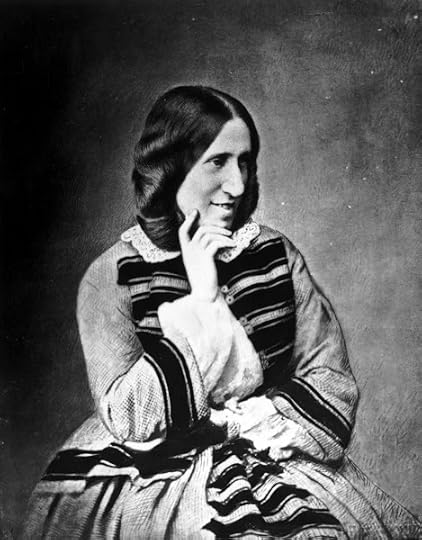 Mary Ann Evans ['George Eliot'] (1819-1880)
Mary Ann Evans ['George Eliot'] (1819-1880)Even making due allowance for the era in which it was compiled, it remains a somewhat surprising selection. There are only two female authors - both English novelists - and Lubbock eventually chose to omit Jane Austen and retain only George Eliot. Even there, it's her first novel Adam Bede, rather than the more mature Middlemarch or Daniel Deronda, which makes the cut.
There's also what would now seem a disproportionate emphasis on Christian theology, ancient and modern. I count no fewer than ten such volumes, ranging from Saint Augustine to Keble's Christian Year. By contrast, there's one book on Buddhism, another on Confucianism, one on Hinduism, and another on Islam.
There are ten British novelists there, too. But who would now think to include Edward Bulwer-Lytton and Charles Kingsley among their number? Cervantes, Goethe, and Voltaire are the only other fiction writers on the list. It's odd, moreover, to see the latter represented by Zadig and Micromegas rather than the more obvious Candide.
It's only to be expected, given Victorian ideas on education, that the Greek and Roman classics should make up a substantial part of the listings - Poets such as Homer, Hesiod, Horace, Lucretius & Virgil; Dramatists such as Aeschylus, Sophocles, Euripides & Aristophanes; Philosophers such as Plato, Aristotle, Epictetus & Marcus Aurelius; Historians such as Herodotus, Livy, Plutarch, Tacitus, Thucydides & Xenophon; Orators such as Demosthenes & Cicero ... In total, they make up almost a quarter of the readings.
To do him justice, Lubbock himself was the first to admit the limitations of his project:
It is one thing to own a library; it is quite another to use it wisely. I have often been astonished how little care people devote to the selection of what they read. Books, we know, are almost innumerable; our hours for reading are, alas! very few. And yet many people read almost by hazard. They will take any book they chance to find in a room at a friend's house; they will buy a novel at a railway-stall if it has an attractive title; indeed, I believe in some cases even the binding affects their choice.He goes on to specify:
The selection is, no doubt, far from easy. I have often wished some one would recommend a list of a hundred good books. If we had such lists drawn up by a few good guides they would be most useful. I have indeed sometimes heard it said that in reading every one must choose for himself, but this reminds me of the recommendation not to go into the water till you can swim.
In the absence of such lists I have picked out the books most frequently mentioned with approval by those who have referred directly or indirectly to the pleasure of reading, and have ventured to include some which, though less frequently mentioned, are especial favorites of my own. Every one who looks at the list will wish to suggest other books, as indeed I should myself, but in that case the number would soon run up.- The Pleasures of Life (1887)
I have abstained, for obvious reasons, from mentioning works by living authors, though from many of them — Tennyson, Ruskin, and others —I have myself derived the keenest enjoyment; and I have omitted works on science, with one or two exceptions, because the subject is so progressive.There's a lot more detail about his specific choices in chapter 4 of The Pleasures of Life, which makes very interesting reading. His reservations about some of the inclusions are particularly revealing. For instance:
I feel that the attempt is over bold, and I must beg for indulgence, while hoping for criticism; indeed one object which I have had in view is to stimulate others more competent far than I am to give us the advantage of their opinions.
Nor must I omit to mention Sir T. Malory's Morte d'Arthur, though I confess I do so mainly in deference to the judgment of others.Or, on the subject of which novelists to include:
Macaulay considered Marivaux's La Vie de Marianne the best novel in any language, but my number is so nearly complete that I must content myself with English: and will suggest Thackeray (Vanity Fair and Pendennis), Dickens (Pickwick and David Copperfield), G. Eliot (Adam Bede or The Mill on the Floss), Kingsley (Westward Ho!), Lytton (Last Days of Pompeii), and last, not least, those of Scott, which indeed constitute a library in themselves, but which I must ask, in return for my trouble, to be allowed, as a special favor, to count as one.
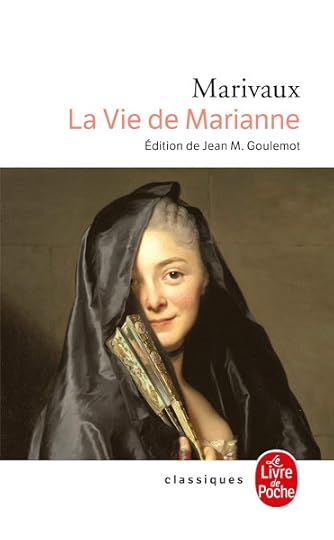 Pierre de Marivaux: La Vie de Marianne (1731-45)
Pierre de Marivaux: La Vie de Marianne (1731-45)Strangely enough, I've actually read La Vie de Marianne. It's a surprisingly entertaining novel, given that its principal subject is the endless rehearsal of the sufferings and woes of the title character - whom I'd always assumed to have been suggested by Samuel Richardson's Pamela in his 1640 novel of that name. Now, however, I see that the dates don't fit, and that if there was influence, it must have been in the opposite direction.
I'm not sure that I'd put it in any lists of must-reads, mind you, but then that just illustrates the invidiousness of such choices. The moment you start to legislate about such things, you end up putting in bizarre tomes such as Samuel Smiles' Self-Help rather than, say, Marx's Das Kapital.
Would it do a modern reader any harm to sit down and start reading their way through Sir John Lubbock's hundred books? No, I don't think so. At the very least it would give you quite a good idea of the classical idea of the canon - as it stood in the late nineteenth century.
I'm not sure that it would do you all that much good, though. You'd have to substitute more reliable texts on the world's great religions, more up-to-date histories than Carlyle's or Grote's, and a greatly increased number of books on economics and science. In fact, you might end up with something like this:
•
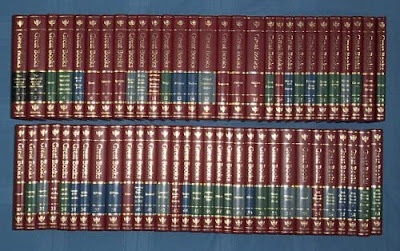 Britannica: Great Books of the Western World (1990)
Britannica: Great Books of the Western World (1990)The Britannica Great Books of the Western World series was first published, as a set of 54 volumes, in 1952:
The original editors had three criteria for including a book in the series drawn from Western Civilization: the book must have been relevant to contemporary matters, and not only important in its historical context; it must be rewarding to re-read repeatedly with respect to liberal education; and it must be a part of "the great conversation about the great ideas", relevant to at least 25 of the 102 "Great Ideas" as identified by the editor of the series's comprehensive index, ... dubbed the "Syntopicon".- WikipediaA second edition, enlarged to 60 volumes, was published in 1990. Among other revisions, "Four women authors were included, where previously there were none."
You can look at the original lists in the Wikipedia article above. I suspect that most of us probably have a few odd volumes of the series kicking around. The double-columns of print and large format make them difficult to read, but they are a useful source for otherwise difficult to locate texts. I see that I myself own ten of them - marked below in bold - though I've never consciously collected them: The Great ConversationSyntopicon ISyntopicon IIVolume 4: Homer (rendered into English prose by Samuel Butler)The IliadThe Odyssey
Homer. The Iliad & The Odyssey. Trans. Samuel Butler. 1898. Great Books of the Western World, 4. Ed. Robert Maynard Hutchins. 1952. Chicago: William Benton, Publisher / Encyclopædia Britannica, Inc., 1989.Aeschylus / Sophocles / Euripides / AristophanesHerodotus / ThucydidesPlatoVolume 8: Aristotle ICategoriesOn InterpretationPrior AnalyticsPosterior AnalyticsTopicsSophistical RefutationsPhysicsOn the HeavensOn Generation and CorruptionMeteorologyMetaphysicsOn the SoulMinor biological works
Aristotle. The Works, Volume 1. Ed. W. D. Ross. Great Books of the Western World, 8. Ed. Robert Maynard Hutchins. Chicago: William Benton, Publisher / Encyclopaedia Britannica, Inc., 1952.Volume 9: Aristotle IIHistory of AnimalsParts of AnimalsOn the Motion of AnimalsOn the Gait of AnimalsOn the Generation of AnimalsNicomachean EthicsPoliticsThe Athenian ConstitutionRhetoricPoetics
Aristotle. The Works, Volume 2. Ed. W. D. Ross. Great Books of the Western World, 9. Ed. Robert Maynard Hutchins. Chicago: William Benton, Publisher / Encyclopaedia Britannica, Inc., 1952.Hippocrates / GalenVolume 11:EuclidThe Thirteen Books of Euclid's Elements ArchimedesOn the Sphere and CylinderMeasurement of a CircleOn Conoids and SpheroidsOn SpiralsOn the Equilibrium of PlanesThe Sand ReckonerThe Quadrature of the ParabolaOn Floating BodiesBook of LemmasThe Method Treating of Mechanical Problems Apollonius of PergaOn Conic Sections Nicomachus of GerasaIntroduction to Arithmetic
Euclid. The Thirteen Books of the Elements / Archimedes. The Works, Including the Method / Apollonius of Perga. On Conic Sections / Nichomachus of Gerga. Introduction to Arithmetic. Trans. Thomas L. Heath, R. Catesby Taliaferro, & Martin L. D’Ooge. 1926 & 1939. Great Books of the Western World, 11. Ed. Robert Maynard Hutchins. Chicago: William Benton, Publisher / Encyclopaedia Britannica, Inc., 1952.Lucretius / Epictetus / Marcus AureliusVirgilVolume 14: PlutarchThe Lives of the Noble Grecians and Romans (translated by John Dryden)
Plutarch. The Lives of the Noble Grecians and Romans (The Dryden Translation). Great Books of the Western World, 14. Ed. Robert Maynard Hutchins. Chicago: William Benton, Publisher / Encyclopaedia Britannica, Inc., 1952.TacitusVolume 16:PtolemyAlmagest, (translated by R. Catesby Taliaferro) Nicolaus CopernicusOn the Revolutions of Heavenly Spheres (translated by Charles Glenn Wallis) Johannes Kepler (translated by Charles Glenn Wallis)Epitome of Copernican Astronomy (Books IV–V)The Harmonies of the World (Book V)
Ptolemy. The Almagest / Copernicus. On the Revolutions of the Heavenly Spheres / Kepler. Epitome of Copernican Astronomy: IV & V; The Harmonies of the World: V. Trans. R. Catesby Taliaferro, & Charles Glenn Wallis. Great Books of the Western World, 16. Ed. Robert Maynard Hutchins. Chicago: William Benton, Publisher / Encyclopaedia Britannica, Inc., 1952.PlotinusSt. AugustineVolume 19: Thomas AquinasSumma Theologica (First part complete, selections from second part, translated by the Fathers of the English Dominican Province and revised by Daniel J. Sullivan)
Aquinas, Thomas. The Summa Theologica, 1. Trans. Fathers of the English Dominican Province. 1941. Rev. Daniel J. Sullivan. Great Books of the Western World, 19. Ed. Robert Maynard Hutchins. Chicago: William Benton, Publisher / Encyclopaedia Britannica, Inc., 1952.Volume 20: Thomas AquinasSumma Theologica (Selections from second and third parts and supplement, translated by the Fathers of the English Dominican Province and revised by Daniel J. Sullivan)
Aquinas, Thomas. The Summa Theologica, 2. Trans. Fathers of the English Dominican Province. 1941. Rev. Daniel J. Sullivan. Great Books of the Western World, 20. Ed. Robert Maynard Hutchins. Chicago: William Benton, Publisher / Encyclopaedia Britannica, Inc., 1952.DanteChaucerMachiavelli / HobbesRabelaisMontaigneShakespeare IShakespeare IIGilbert / Galileo / HarveyCervantes: Don QuixoteSir Francis BaconDescartes / SpinozaMiltonPascalNewton / HuygensLocke/ Berkeley / HumeSwift: Gulliver's Travels / Sterne: Tristram ShandyFielding: Tom JonesMontesquieu / RousseauAdam SmithGibbon: The Decline and Fall of the Roman Empire IGibbon: The Decline and Fall of the Roman Empire IIKantAmerican State Papers / Hamilton, Madison, Jay: The Federalist / John Stuart MillBoswell: Life of JohnsonLavoisier / Fourier / FaradayHegelGoethe: FaustMelville: Moby DickDarwinKarl Marx / Friedrich EngelsTolstoy: War and PeaceDostoevsky: The Brothers KaramazovVolume 53: William JamesThe Principles of Psychology
James, William. The Principles of Psychology. Great Books of the Western World, 53. Ed. Robert Maynard Hutchins. Chicago: William Benton, Publisher / Encyclopaedia Britannica, Inc., 1952.Volume 54: Sigmund FreudThe Origin and Development of Psycho-AnalysisSelected Papers on HysteriaThe Sexual Enlightenment of ChildrenThe Future Prospects of Psycho-Analytic TherapyObservations on "Wild" Psycho-AnalysisThe Interpretation of DreamsOn NarcissismInstincts and Their VicissitudesRepressionThe UnconsciousA General Introduction to Psycho-AnalysisBeyond the Pleasure PrincipleGroup Psychology and the Analysis of the EgoThe Ego and the IdInhibitions, Symptoms, and AnxietyThoughts for the Times on War and DeathCivilization and Its DiscontentsNew Introductory Lectures on Psycho-Analysis
Freud, Sigmund. The Major Works. Great Books of the Western World, 54. Ed. Robert Maynard Hutchins. Chicago: William Benton, Publisher / Encyclopaedia Britannica, Inc., 1952.
•
Again it seems, in retrospect, 70 years on, quite an odd list. It's very anglocentric, for a start: Boswell's Life of Johnson, a whole slew of novels and other literary works easily available elsewhere ... but it does represent a certain advance on Lubbock, insofar (at least) that it admits upfront its 'Western' orientation - if you'll forgive the pun.
The editors were well aware of this, however, so when they revised it in 1990, they added six new volumes of more contemporary material: one on Philosophy, one on Science, one on Economics, one on Anthropology, and two on Modernist Literature (you can see further details here).
Like all such grand intellectual enterprises, however, it looks now more like an index of the blind-spots in the late twentieth-century mind than a truly satisfactory summary of the best of Western thought.
•
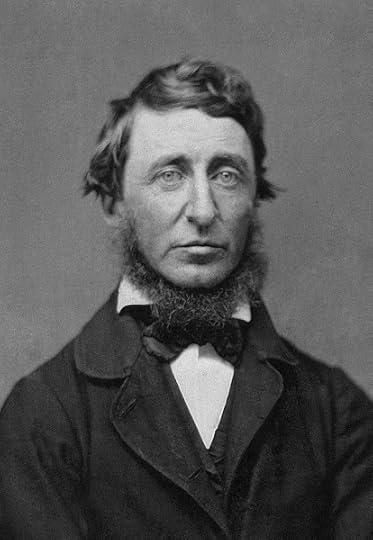 Henry David Thoreau (1817-1862)
Henry David Thoreau (1817-1862)So what's my conclusion? "Beware of all enterprises that require new clothes," as Henry Thoreau put it so succinctly (or, as in this case, new book-bindings). But he went on to say: "and not rather a new wearer of clothes" - which is perhaps the nub of the matter.
No set list of readings will produce an original, free-thinking intellect, whether it be Sir John Lubbocks's 100 books, the Britannica Great Books, the Harvard Classics, or The Sacred Books of the East. That's not to say that such collections of books have no abiding usefulness, however - it's probably better to take them as a series of local guides than as a grand, overarching index to the nature of the universe, however.
And, in the meantime, it can be useful - and salutary - to skim through such lists and remind yourself of just how far you've fallen short of the minimum knowledge expected of either a nineteenth-century or a more contemporary 'common reader'!
•
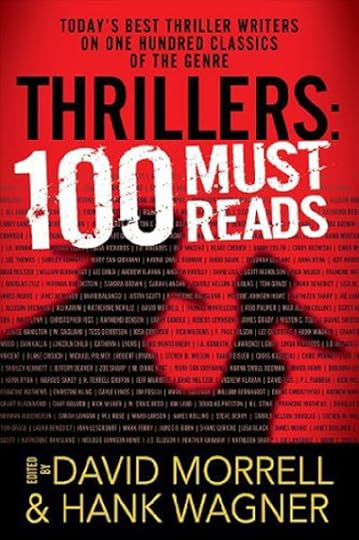 David Morrell & Hank Wagner: Thrillers: 100 Must-Reads (2010)
David Morrell & Hank Wagner: Thrillers: 100 Must-Reads (2010)
Published on August 28, 2022 16:21
August 22, 2022
Sandmania
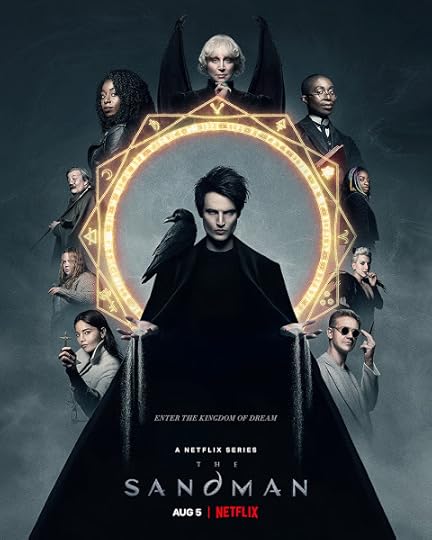 The Sandman (Netflix, 2022- )
The Sandman (Netflix, 2022- )It's actually quite hard for me to remember a time before I knew Sandman. The graphic novel, that is, not the TV series. That's pretty new to all of us, I suppose.
 Neil Gaiman: World's End (1994)
Neil Gaiman: World's End (1994)And yet, I do dimly recall getting out a single volume of The Sandman Library out from the Auckland Central Library. Sometime in the late 1990s, it must have been. The book in question was No. 8: World’s End, which was, in retrospect, not a bad introduction to strange and intricate world of Neil Gaiman's comic.
 Neil Gaiman: World's End (1994)
Neil Gaiman: World's End (1994)After that I read odd volumes as they came to hand - mostly completely out of sequence, unfortunately - until I had more or less grasped the whole thing. At which point I realised that I really had to own it all myself, and started buying the ones available in Borders, then online, until I had a complete set and could read the whole work from start to finish.
According to Wikipedia, The original series ran for 75 separate issues, each with a cover by , from January 1989 to March 1996. When collected subsequently for book publication, it was divided into the following volumes:
Preludes and Nocturnes, illustrated by Sam Kieth, Mike Dringenberg & Malcolm Jones III, coloured by Robbie Busch, and lettered by Todd Klein, collects The Sandman #1–8 (1988–1989)The Doll's House, illustrated by Mike Dringenberg, Malcolm Jones III, Chris Bachalo, Michael Zulli & Steve Parkhouse, coloured by Robbie Busch, and lettered by Todd Klein, collects The Sandman #9–16 (1989–1990)Dream Country, illustrated by Kelley Jones, Charles Vess, Colleen Doran & Malcolm Jones III, coloured by Robbie Busch & Steve Oliff, and lettered by Todd Klein, collects The Sandman #17–20 (1990)Season of Mists, illustrated by Kelley Jones, Mike Dringenberg, Malcolm Jones III, Matt Wagner, Dick Giordano, George Pratt & P. Craig Russell, coloured by Steve Oliff & Daniel Vozzo, and lettered by Todd Klein, collects The Sandman #21–28 (1990–1991)A Game of You, illustrated by Shawn McManus, Colleen Doran, Bryan Talbot, George Pratt, Stan Woch & Dick Giordano, coloured by Daniel Vozzo, and lettered by Todd Klein collects The Sandman #32–37, 1991–1992)Fables and Reflections, illustrated by Bryan Talbot, Stan Woch, P. Craig Russell, Shawn McManus, John Watkiss, Jill Thompson, Duncan Eagleson, Kent Williams, Mark Buckingham, Vince Locke & Dick Giordano, coloured by Daniel Vozzo & Lovern Kindzierski/Digital Chameleon, and lettered by Todd Klein, collects The Sandman #29–31, 38–40, 50; The Sandman Special #1; and Vertigo Preview No. 1 (1991–1993)Brief Lives, illustrated by Vince Locke, Dick Giordano & Jill Thompson, coloured by Daniel Vozzo, and lettered by Todd Klein, collects The Sandman #41–49 (1992–1993)Worlds' End, illustrated by Michael Allred, Gary Amaro, Mark Buckingham, Dick Giordano, Tony Harris, Steve Leialoha, Vince Locke, Shea Anton Pensa, Alec Stevens, Bryan Talbot, John Watkiss & Michael Zulli, coloured by Danny Vozzo, and lettered by Todd Klein, collects The Sandman #51–56 (1993)The Kindly Ones, illustrated by Marc Hempel, Richard Case, D'Israeli, Teddy Kristiansen, Glyn Dillon, Charles Vess, Dean Ormston & Kevin Nowlan, coloured by Daniel Vozzo, and lettered by Todd Klein, collects The Sandman #57–69 and Vertigo Jam No. 1 (1993–1995)The Wake, illustrated by Michael Zulli, Jon J. Muth & Charles Vess, coloured by Daniel Vozzo & Jon J. Muth, and lettered by Todd Klein, collects The Sandman #70–75 (1995–1996)If you're suprised to see quite so much detail here about who illustrated, coloured, and lettered each issue, it's important to emphasise that the creation of American mass-market comics depends on taking a team approach. There's no other way to guarantee enough product on the newstands every month.
Simply put, the writer supplies a blow-by-blow account of what they have in mind (there are sample scripts in some of the Sandman reprints, if you're curious to see what these look like). The penciller does a rough sketch of each panel and page. The inker then draws in a final version of these images (with revisions, if necessary). The colours are then added by a further artist, after which the dialogue and captions are lettered into each speech balloon and inset panel.
This sounds like - and, I gather, is - quite a laborious process. Individual comics auteurs tend to take care of most or all of these levels of production all by themselves. But that's one reason why lone wolf comics take such an inordinate amount of time to create.
The work involved is staggering, and when one adds the information - supplied by Gaiman himself - that each page of his comics requires about four pages of description, the true scale of such enterprises as The Sandman begins to come into focus: 3,000-odd pages of comic = roughly 12,000 pages of writing.
What, then, of the TV series, revealed to us finally after 30 years in development limbo? Well, fans will immediately note some changes and elisions: John Constantine has been replaced by his ancestor Lady Johanna Constantine, and a number of characters (including Death) have changed their ethnicity. All in all, though, such shifts are less notable than the number of things which have remained intact.
And one can already detect, at the end of the first series (roughly covering the first two volumes of the comic) the plotlines lining up for more momentous developments in Morpheus's journey. Overall, I'd say I liked it a lot. It's rather schmaltzy at times, but then so is the comic. It's also gruesome - which I liked less - but then that's true to the spirit of the original, too.
One thing I particularly appreciated was how slow-moving most of the episodes were. There was none of that break-neck, frenetic pace which such shows as Dr Who have increasingly adopted as their trademark technique for engaging with 'youth'. Morpheus, by contrast, speaks slowly and deliberately and has long, detailed conversations with his collaborators (and victims) before making each of his moves on the celestial chessboard.
It was, in other words, written for people with a brain - whether they happened to be young or old - rather than the guppy attention-spanned audiences generally courted by streaming providers. The special effects are rich and (for the most part) well realised, and the episodes nicely balanced between atmosphere and action.
If the overall intention was to hook us on yet another epic fantasy serial like Game of Thrones, with its year-long waits between series, I'm afraid that they've been only too successful. I, for one, will be waiting impatiently to see where they go next with it. Bronwyn is so anxious to know what happens next that she may have to resort to reading the comics!
•
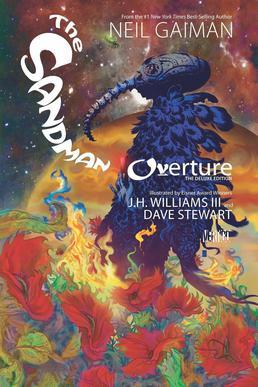 Neil Gaiman et al. The Sandman: Overture (2013)
Neil Gaiman et al. The Sandman: Overture (2013)There's a large number of spin-offs, sequels and part-sequels to The Sandman, some written by Gaiman himself and some by other people. Few of them could be said to be really essential reading, but there are some exceptions.
The most extended example, Mike Carey's Lucifer - which I suspect will survive its dreadful TV adaptation (even worse than the one of Gaiman's novel American Gods, which is saying something) - is, imho, a bona fide masterpiece which challenges comparison even with its original:
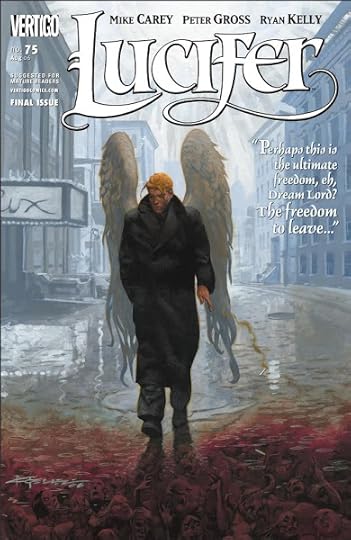 Mike Carey: Lucifer (1999-2007)
Mike Carey: Lucifer (1999-2007)Lucifer 1: Devil in the Gateway. The Sandman Presents – Lucifer 1-3: 1999 & Lucifer 1-4: 2000. New York: Vertigo/DC Comics, 2001. Lucifer 2: Children and Monsters. Lucifer 5-13: 2000. New York: Vertigo/DC Comics, 2001.Lucifer 3: A Dalliance with the Damned. Lucifer 14-20: 2001. New York: Vertigo/DC Comics, 2002.Lucifer 4: The Divine Comedy. Lucifer 21-28: 2002. New York: Vertigo/DC Comics, 2003.Lucifer 5: Inferno. Lucifer 29-35: 2003. New York: Vertigo/DC Comics, 2004.Lucifer 6: Mansions of the Silence. Lucifer 36-41: 2003. New York: Vertigo/DC Comics, 2004.Lucifer 7: Exodus. Lucifer 42-44, 46-49: 2004. New York: Vertigo/DC Comics, 2005.Lucifer 8: The Wolf beneath the Tree. Lucifer 45, 50-54: 2004. New York: Vertigo/DC Comics, 2005.Lucifer 9: Crux. Lucifer 55-61: 2005. New York: Vertigo/DC Comics, 2006.Lucifer 10: Morningstar. Lucifer 62-69: 2006. New York: Vertigo/DC Comics, 2006.Lucifer 11: Evensong. Lucifer – Nirvana: 2002 & Lucifer 70-75: 2006. New York: Vertigo/DC Comics, 2007.
Some of the others, such as the 2013 "Overture" to The Sandman are also worth a look. I've provided a partial list below, but for more information, you could do worse than look here.
There's even, now, an annotated edition compiled by the indefatigable Leslie S. Klinger.
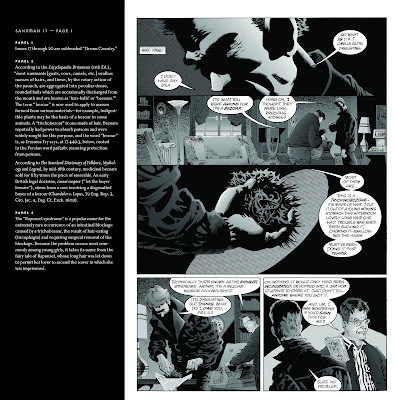 Leslie S. Klinger: The Annotated Sandman (2012-15)
Leslie S. Klinger: The Annotated Sandman (2012-15)•
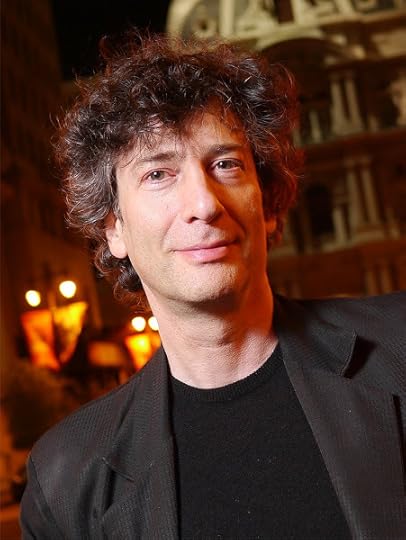 Neil Gaiman (2013)
Neil Gaiman (2013)Neil Richard MacKinnon Gaiman
(1960- )
Comics:
[with Dave McKean] Violent Cases (1987)[with Dave McKean] Black Orchid (1988–1989 / 1991)Sandman (1989-1996)The Sandman Library I: Preludes & Nocturnes. 1991. New York: Vertigo/DC Comics, 1995.The Sandman Library II: The Doll’s House. 1990. New York: Vertigo/DC Comics, 1995.The Sandman Library III: Dream Country. 1991. New York: Vertigo/DC Comics, 1995.The Sandman Library IV: Season of Mists. New York: Vertigo/DC Comics, 1992.The Sandman Library V: A Game of You. New York: Vertigo/DC Comics, 1993.The Sandman Library VI: Fables & Reflections. New York: Vertigo/DC Comics, 1993.The Sandman Library VII: Brief Lives. New York: Vertigo/DC Comics, 1994.The Sandman Library VIII: World’s End. New York: Vertigo/DC Comics, 1994.The Sandman Library IX: The Kindly Ones. New York: Vertigo/DC Comics, 1996.The Sandman Library X: The Wake. New York: Vertigo/DC Comics, 1997.[with Yoshitaka Amano] The Sandman: The Dream Hunters. New York: Vertigo/DC Comics, 1999.The Sandman: Endless Nights. New York: Vertigo/DC Comics, 2003.The Sandman: Overture. 2013-15. New York: Vertigo/DC Comics, 2016.The Books of Magic (1990-1991)The Books of Magic. 1990-91; 1993. New York: Vertigo/DC Comics, 2001.Death (1993-1996)Death: The High Cost of Living. New York: Vertigo/DC Comics, 1994.Death: The Time of Your Life. New York: Vertigo/DC Comics, 1997.The Last Temptation (1994-1995)[with Alice Cooper] The Last Temptation. Illustrated by Michael Zulli. 1994-95. Oregon: Dark Horse Comics, 2000.[with Dave McKean] The Tragical Comedy or Comical Tragedy of Mr. Punch (1994-1995)Neil Gaiman's Midnight Days (1999)Midnight Days. 1989-95. New York: Vertigo/DC Comics, 1999.Marvel 1602 (2003-2004)Marvel 1602. Illustrated by Andy Kubert. 2003-4. New York: Marvel Worldwide Inc., 2013.A Study in Emerald (2018)A Study in Emerald. Illustrated by Rafael Albuquerque. Milwaukie, Oregon: Dark Horse Books, 2018.
Novels:
[with Terry Pratchett] Good Omens (1990)Good Omens: The Nice and Accurate Prophecies of Agnes Nutter, Witch. A Novel. London: Victor Gollancz Ltd., 1990.Neverwhere (1996)Neverwhere. 1996. New York: HarperTorch, 2001.Neverwhere: Author's Preferred Text, with How the Marquis Got His Coat Back. 1996 & 2014. William Morrow. New York: HarperCollins Publishers, 2016.Stardust (1999)Stardust. London: Headline Book Publishing, 1999.American Gods (2001)American Gods. London: Headline Book Publishing, 2001.American Gods: The Author's Preferred Text. 2001 & 2004. Review. London: Headline Book Publishing, 2005.Anansi Boys (2005)Anansi Boys. London: Headline Book Publishing, 2005.[with Michael Reaves] InterWorld. InterWorld Series 1 (2007)The Graveyard Book (2008)The Graveyard Book. Illustrated by Chris Riddell. 2008. London: Bloomsbury Publishing Plc, 2009.[with Michael Reaves & Mallory Reaves] The Silver Dream. InterWorld Series 2 (2013)The Ocean at the End of the Lane (2013)The Ocean at the End of the Lane. London: Headline Publishing Group, 2013.[with Michael Reaves & Mallory Reaves] Eternity's Wheel. InterWorld Series 2 (2015)
Picture Books:
The Day I Swapped My Dad for Two Goldfish. Illustrated by Dave McKean (1997)[with Gene Wolfe] A Walking Tour of the Shambles. Illustrated by Randy Broecker (2002)Coraline. Illustrated by Dave McKean (2002) Coraline. Illustrations by Dave McKean. 2002. New York: Harper Trophy, 2003.The Wolves in the Walls. Illustrated by Dave McKean (2003)Melinda. Illustrated by Dagmara Matuszak (2005)MirrorMask. Illustrated by Dave McKean (2005)Mirrormask. Illustrated by Dave McKean. London: Bloomsbury Publishing Plc, 2005.Odd and the Frost Giants. Illustrated by Brett Helquist (2008)The Dangerous Alphabet. Illustrated by Gris Grimly (2008)Blueberry Girl. Illustrated by Charles Vess (2009)Crazy Hair. Illustrated by Dave McKean (2009)Instructions. Illustrated by Charles Vess (2010)Chu's Day. Illustrated by Adam Rex (2013)Fortunately, the Milk. Illustrated by Skottie Young, US / Chris Riddell, UK / Boulet, France (2013)Chu's First Day of School. Illustrated by Adam Rex (2014)Hansel and Gretel. Illustrated by Lorenzo Mattotti (2014)The Sleeper and the Spindle. Illustrated by Chris Riddell (2014)Chu's Day at the Beach. Illustrated by Adam Rex (2016)Cinnamon. Illustrated by Divya Srinivasan (2017)Pirate Stew. Illustrated by Chris Riddell (2020)
Short Fiction:
Angels and Visitations (1993)Smoke and Mirrors (1998)Smoke and Mirrors: Short Fictions and Illusions. London: Headline Book Publishing, 1999.Smoke and Mirrors: Short Fiction and Illusions. 1999. Headline Feature. London: Headline Book Publishing, 2000.Fragile Things (2006)Fragile Things: Short Fictions and Wonders. 2006. London: Headline Publishing Group, 2013.M is for Magic (2007)Who Killed Amanda Palmer (2009)A Little Gold Book of Ghastly Stuff (2011)Trigger Warning (2015)Trigger Warning: Short Fictions and Disturbances. London: Headline Publishing Group, 2015.The Neil Gaiman Reader (2020)The Neil Gaiman Reader: Selected Fiction. Foreword by Marlon James. London: Headline Publishing Group, 2020.
Non-fiction:
Duran Duran: The First Four Years of the Fab Five (1984)[with Kim Newman] Ghastly Beyond Belief (1985)Ghastly Beyond Belief. Ed. Neil Gaiman & Kim Newman. Introduction by Harry Harrison. London: Arrow Books, 1985.Don't Panic: A Biography of Douglas Adams (1988)Adventures in the Dream Trade (2002)Make Good Art: A Commencement Speech Given at the UArts on 17 May 2012 (2013)The View from the Cheap Seats (2016)The View from the Cheap Seats: Selected Non-fiction. London: Headline Publishing Group, 2016.Norse Mythology (2017)Norse Mythology. London: Bloomsbury Publishing Plc, 2017.
Screenplays:
[with storyboards by Dave McKean] MirrorMask: The Illustrated Film Script (2005)[with Roger Avary] Beowulf: The Script Book (2007)
Secondary:
Bender, Hy. The Sandman Companion. New York: Vertigo/DC Comics, 1999.
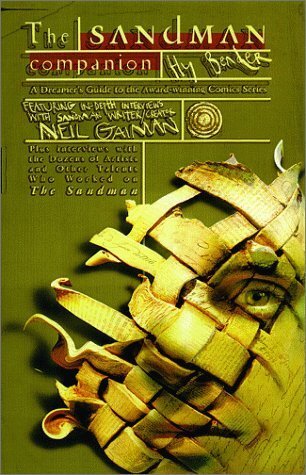 Hy Bender: The Sandman Companion (1999)
Hy Bender: The Sandman Companion (1999)
Published on August 22, 2022 14:47
August 13, 2022
Devonport Library Poetry Reading - Tuesday 23/8/22
 Te Pātaka Kōrero o Te Hau Kapua / Devonport Library
Te Pātaka Kōrero o Te Hau Kapua / Devonport LibraryWaxing Lyrical
The Devonport Library Associates present Jack Ross with Johanna Emeney, Elizabeth Morton, Lisa Samuels and Bryan Walpert, all eminent poets reading from their own works.
Jack is a recent editor of Poetry New Zealand.
This event is part of Auckland Libraries’ We Read Auckland | Ka Pānui Tātau I Tāmaki Makaurau.

The idea of this reading, which coincides with the beginning of the Auckland Writers Festival, is to celebrate the reopening of the Devonport Library's event series - after a couple of years of pandemic-prompted closures - with a showcase of local, North Shore-based poets.
Each writer will have the chance to read a representative sample from their work. Their latest books will also be on sale, thanks to our friends at Paradox Books.
The real heroes of the occasion are, however, the Devonport Library Associates: chair Jan Mason, events organiser Paul Beachman, and publicity courtesy of Linda Hopkins.
•
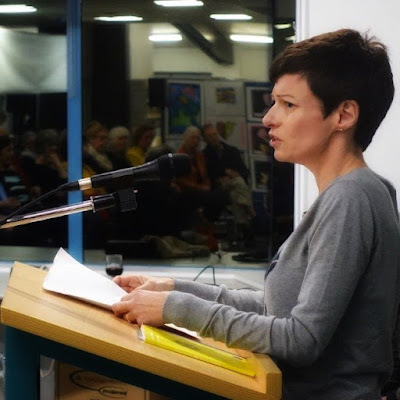 Johanna Emeney
Johanna Emeney
Johanna Emeney lives with her husband David and a family of cats, goats, sheep and ponies. Jo’s latest book, co-written with Sarah Laing, launches on September 7th, 6pm at Takapuna Library. Sylvia and the Birds is part-biography of Bird Lady Sylvia Durrant and part call-to-arms for young environmental activists.
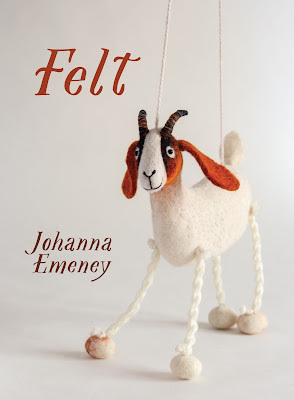 Johanna Emeney: Felt (2021)
Johanna Emeney: Felt (2021)•
 Elizabeth Morton
Elizabeth Morton
Elizabeth Morton is an Auckland writer, with three collections of poetry, the latest being Naming the Beasts (Otago University Press). She holds an MLitt from the University of Glasgow, and is completing an MSc at Kings College London. Her writing has appeared in publications from New Zealand, the UK, the USA, Canada, Ireland, Australia and online.
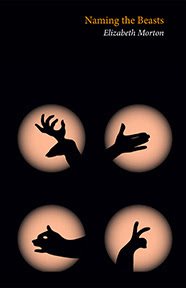 Elizabeth Morton: Naming the Beasts (2022)
Elizabeth Morton: Naming the Beasts (2022)•
 Jack Ross
Jack Ross
Jack Ross is the author of six poetry collections, most recently The Oceanic Feeling (2021), as well as numerous works of fiction, including The Annotated Tree Worship, highly commended in the 2018 NZSA Heritage Book Awards. He was managing editor of Poetry New Zealand from 2014-2020, and has edited many other books, anthologies, and literary journals. He lives in Mairangi Bay and blogs at The Imaginary Museum.
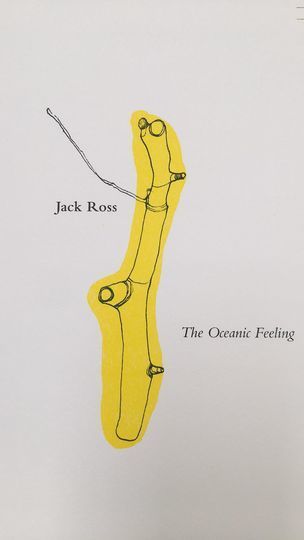 Jack Ross: The Oceanic Feeling (2021)
Jack Ross: The Oceanic Feeling (2021)•
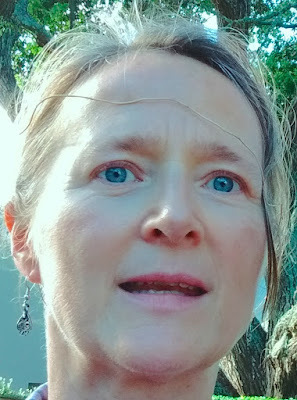 Lisa Samuels
Lisa Samuels
Lisa Samuels is Professor of English at the University of Auckland and the author of eighteen books, mostly poetry, and of many influential essays on theories of interpretation and body ethics. Lisa also works with sound, visual art, film, and editing, including co-editing the anthology A Transpacific Poetics (Litmus Press 2017). Her most recent poetry book is Breach (Boiler House Press 2021), and a Serbian translation of her novel Tender Girl has just been published by Partizanska Press.
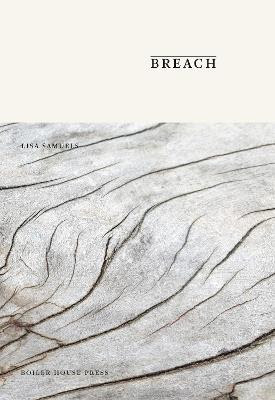 Lisa Samuels: Breach (2021)
Lisa Samuels: Breach (2021)•
 Bryan Walpert
Bryan Walpert
Bryan Walpert is the author of four books of poems, most recently Brass Band to Follow (Otago UP), named among the top 10 poetry collections of 2021 by the NZ Listener. He is also the author of three books of fiction, including the novel Entanglement, short-listed for the Jann Medlicott Acorn Prize for Fiction at the 2022 Ockham New Zealand Book Awards. A Devonport resident, he is a Professor of Creative Writing at Massey University-Albany.
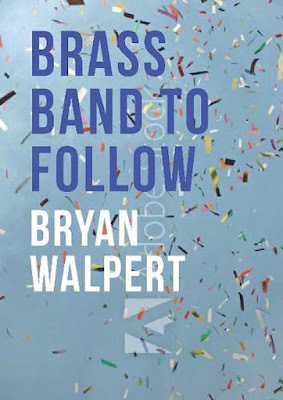 Bryan Walpert: Brass Band to Follow (2021)
Bryan Walpert: Brass Band to Follow (2021)•
Published on August 13, 2022 15:07
July 31, 2022
The Many Faces of Dorothy L. Sayers
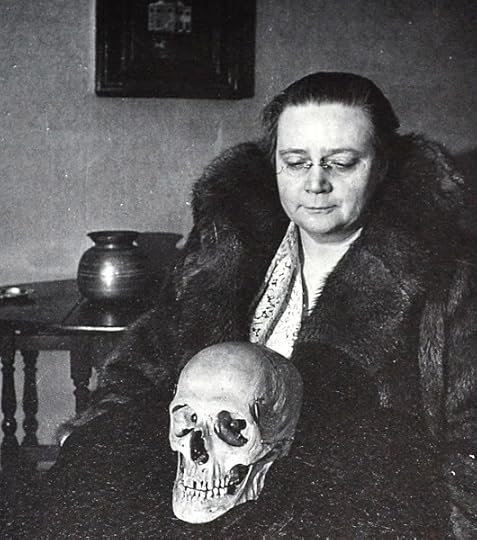 Dorothy L. Sayers (1893-1957)
Dorothy L. Sayers (1893-1957)When my mother left her hometown of Sydney, Australia in 1953 to take up her very first job as a house surgeon in a little country hospital in Waimate, New Zealand, among the very few things she brought with her was her collection of books by Dorothy Sayers.
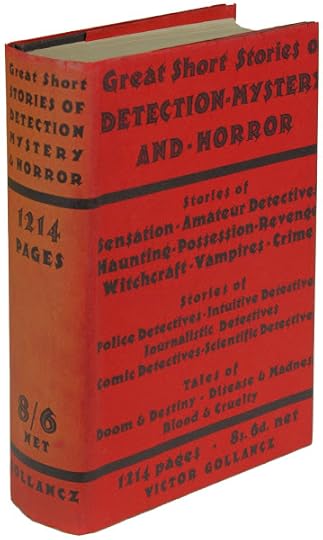 Dorothy L. Sayers, ed. : Great Short Stories of Detection, Mystery and Horror (1928)
Dorothy L. Sayers, ed. : Great Short Stories of Detection, Mystery and Horror (1928)I suppose that might be where I got it from: this persistent taste for the occult and the macabre - not so much the detection bit, but certainly the mystery and horror.
I've read all the Lord Peter Wimsey detective stories many times, but - more to the point - have found perhaps even more to admire in the acumen with which Sayers mapped the whole field of the mysterious in three soup-to-nuts anthologies, issued over a period of seven years, from 1928 to 1934.
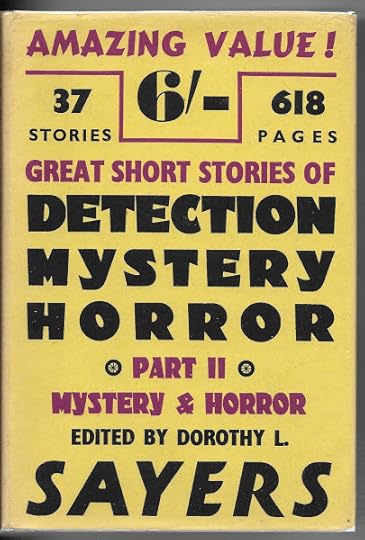
Dorothy L. Sayers, ed. : Great Short Stories of Detection, Mystery and Horror (1928)
Originally published in three large volumes, these collections were subsequently subdivided into six separate sections: three confined to detective stories, and another three devoted to ghost and horror stories.
This has made things far easier for fans of both genres, as the rationalists don't have to be bothered with all the supernatural stuff, and occultists such as myself don't have to pretend interest in the creaky mechanics of whodunnits.
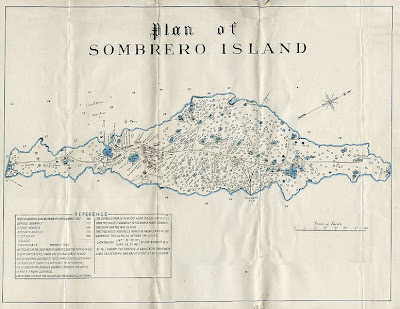 Sombrero Island
Sombrero IslandIt was there that I first encountered Le Fanu's 'Green Tea' and 'Carmilla', Bram Stoker's 'The Judge's House', and a host of more recent luminaries of the macabre. And it was there that I first read one of my very favourite short stories of all time, Martin Armstrong's 'Sombrero' (which you can read about it in more detail in Bronwyn Lloyd's brilliant essay here).
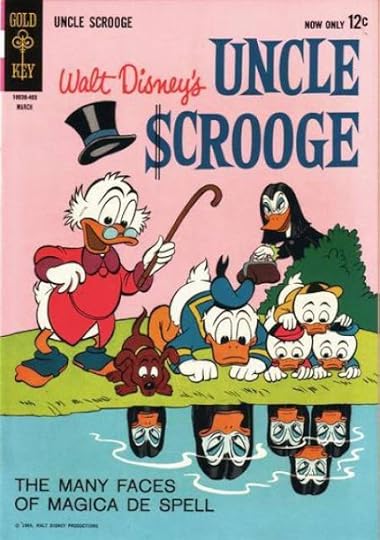 Carl Barks: The Many Faces of Magica de Spell (1964)
Carl Barks: The Many Faces of Magica de Spell (1964)But who exactly was Dorothy Sayers, and why do her various sets of fans still maintain such devotion to her memory? Why, in particular, do those fans seem content to remain in such mutually exclusive groups?
The Many Faces of Dorothy Sayers, then, would have to include: her dazzling contribution to the Golden Age of Detective Fiction, as a contemporary (and rival) of Agatha Christie, Ngaio Marsh, and Josephine Tey, amongst others. her work as a translator - and commentator - on Dante, which resulted in one of the most widely read versions of the Divine Comedy published in modern times.her status as a visiting member of the Inklings, with C. S. Lewis and J. R. R. Tolkien, due mainly to her extensive contributions to the field of Christian apologetics.and, last but not least, her work as a critic and anthologist of mystery and ghost stories, which rivals even that of such industrious successors as Edmund Crispin and Peter Haining.
Let's take them one by one:
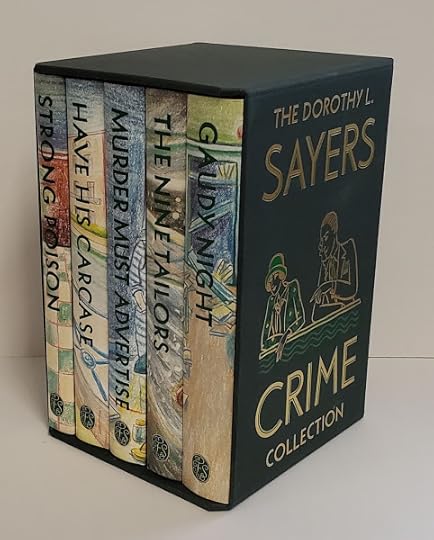 The Dorothy L. Sayers Crime Collection (Folio Society: 1998)
The Dorothy L. Sayers Crime Collection (Folio Society: 1998)Detective Story Writer
Lord Peter Wimsey novels:
Whose Body? (1923)Clouds of Witness (1926)Unnatural Death (1927)The Unpleasantness at the Bellona Club (1928)Strong Poison (1930) [with Harriet Vane]The Five Red Herrings (1931)Have His Carcase (1932) [with Harriet Vane]Murder Must Advertise (1933)The Nine Tailors (1934)Gaudy Night (1935) [with Harriet Vane]Busman's Honeymoon (1937) [with Harriet Vane]
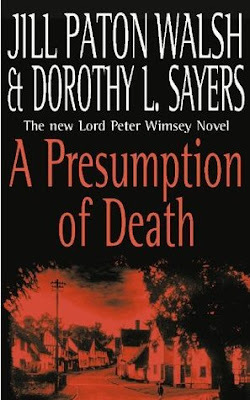 Jill Paton Walsh & Dorothy L. Sayers: A Presumption of Death (2002)
Jill Paton Walsh & Dorothy L. Sayers: A Presumption of Death (2002)I recently came across an interesting paperback in a local vintage shop. It purports to be a collaboration between children's-book and detective-story writer Jill Paton Walsh and the long defunct Dorothy Sayers.
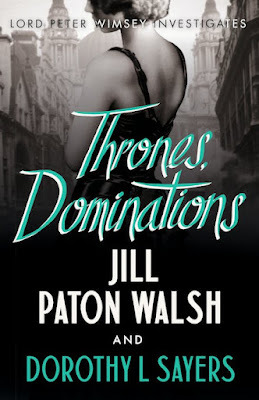 Dorothy L. Sayers & Jill Paton Walsh: Thrones, Dominations (1998)
Dorothy L. Sayers & Jill Paton Walsh: Thrones, Dominations (1998)Further research revealed the existence of an earlier volume which actually was based on some unpublished chapters of an unfinished Lord Peter Wimsey novel started by Sayers sometime in 1936, after the completion of Busman's Honeymoon, the last published Wimsey mystery.
Busman's Honeymoon was written as a stage play before being repackaged as a novel, an interesting change of gear which might lead one to argue that the last bona fide Sayers crime novel was in fact Gaudy Night (1935), which ends with her (at least partial) alter ego, crime novelist Harriet Vane, falling at last into the faithful arms of aristocratic sleuth Lord Peter Wimsey.
I enjoyed both of these Walsh / Sayers novels, though perhaps not sufficiently to hunt out the further instalments in the series. Jill Paton Walsh died in 2020, so there are unlikely to be any more beyond the four already completed by her - unless, that is, some enterprising fan-fiction writer discovers unpublished chapters or plot outlines for further such books, and so ad infinitum ...
Walsh certainly manages a pretty seamless join between her chapters and Sayers' chapters in the 1936-37 abdication era saga of Thrones, Dominations. She is also pretty good on the atmosphere of wartime Britain in A Presumption of Death. What one misses in both books, though, is the relentlessly circumstantial detail of the canonical Wimsey stories.
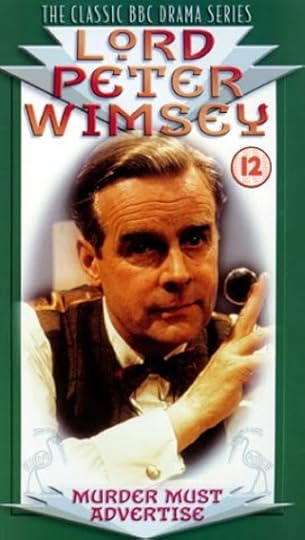 Ian Carmichael as Lord Peter Wimsey in Murder Must Advertise (BBC: 1973)
Ian Carmichael as Lord Peter Wimsey in Murder Must Advertise (BBC: 1973)What was it like to work in an advertising agency in the 1930s? Sayers had done so, and she paints a vivid picture of the minutiae of the trade in Murder Must Advertise (1933). In fact, so absorbing is her account that one's interest - never strong - in solving the murder mystery the novel is purportedly about begins to shrink into nothingness.
The same could be said in even stronger terms about the apprenticeship in Campanology (or bell-ringing) offered by The Nine Tailors (1934). Painting in oils is exhaustively canvassed in The Five Red Herrings (1931), and any questions one may have had about the functioning of Oxford women's colleges before the war are very fully answered by Gaudy Night (1935).
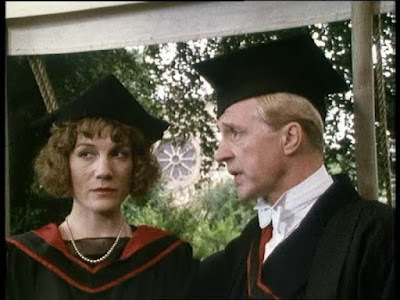 Harriet Walters as Harriet Vane / Edward Petherbridge as Wimsey in Gaudy Night (BBC: 1987)
Harriet Walters as Harriet Vane / Edward Petherbridge as Wimsey in Gaudy Night (BBC: 1987)This tendency on Sayers' part to go off into a disquisition on the collecting of incunabula (books printed before 1500 - one of wealthy Lord Peter's principal passions), or some other esoteric topic, instead of sticking to the grimier details of blood-stains and alibis did not go unremarked at the time. Detective story purists decried this lack of focus on the usual content of such stories.
It is, however, one of the main reasons why they remain so readable almost a century after the Wimsey series began in 1923. She wrote them, at least initially, for money. As time went by, and her sources of income diversified, she continued them as a vehicle for her other passions: old books, and scholarship, and medieval pageantry.
I mentioned in an earlier post certain problems some readers have had with Whose Body? (1923), the first of the Wimsey novels. The fact that the victim is Jewish and his murderer overtly anti-semitic does not, in my view, add up to evidence that Sayers herself shared these views - on the contrary, in fact. There are admittedly certain parts of the book which read oddly today, but no more so than any other thriller of the time, I would argue.
This may be one reason why her subsequent books stick to subjects of more Academic interest. I can see how this might irritate fans of (say) Agatha Christie or the American hard-boiled tradition, but the long, languorous descriptions of Lord Peter's bookshelves with which Sayers occasionally indulges herself have probably drawn in more readers than they've driven away. Bookish folk are a clannish tribe, and the great thing about Sayers - like her near-contemporary M. R. James - is that she does know what she's talking about.
It's easy enough to plaster together a few Latin tags and booktitles from the likes of Wikipedia if you want to feign close knowledge of some esoteric field. Sayers never does that. It's not just that she fleshes out her account of such things from her own wide reading and classical education. It's also clear that she's speaking from the heart. Feigned enthusiasm can generally be distinguished from the real thing.
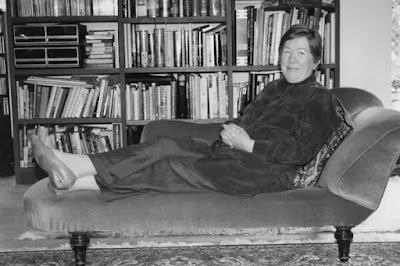 Jill Paton Walsh (1937-2020)
Jill Paton Walsh (1937-2020)Jill Paton Walsh was a very well-informed and experienced writer. When, however, she attempts to emulate Sayers' expositions of esoteric areas of learning (the short account of the lost rivers of London in Thrones, Dominations, for instance - or the details of code-breaking and spycraft generally in A Presumption of Death), the results fall too far short of the original to satisfy.
I see no harm in what she's done - and wish her publishers well in continuing to market these four novels - but the Sayers canon will remain eleven novels and a number of short stories. Unsurprisingly, Walsh channels Harriet Vane far more convincingly than she does Lord Peter. The latter is a pallid shade of his jazz-era self. Harriet, by contrast, seems almost as self-involved and incompetent a detective as she was in the original books.
The fact that the process of fleshing out Lord Peter's genealogy and post-war career began during Sayers' own lifetime, and that she even collaborated with some of these attempts, can presumably be attributed to her passion for the so-called 'higher criticism' (a term coined by Monsignor Ronald Knox) of Sherlock Holmes.
There are many Holmes ephemera and sequels also. As long as they don't draw away too much attention from the parent tree, they're as pleasant a way of wasting one's time as any, I'd say.
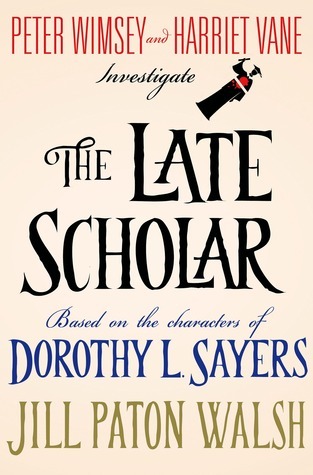 Jill Paton Walsh: The Late Scholar (2013)
Jill Paton Walsh: The Late Scholar (2013)•
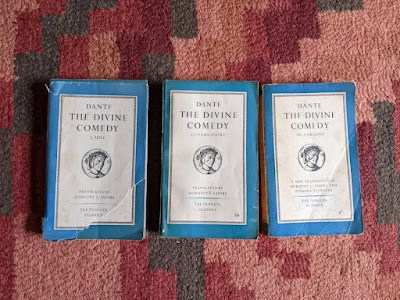 Dorothy L. Sayers, trans. The Comedy of Dante Alighieri (Penguin Classics: 1949-62)
Dorothy L. Sayers, trans. The Comedy of Dante Alighieri (Penguin Classics: 1949-62)Verse Translator
I've already had a bit to say on this subject, too, in a post on Dante's Divine Comedy where I compare a number of translations - including Dorothy Sayers' - of the opening lines of the poem.
There's no need to repeat all that here, but I should perhaps mention Sayers' own comments on what she'd been trying to do in her own version of this much-English'd poem, which she seems almost alone in regarding as a 'comedy' in the modern sense:
the pervading favour of Dante's humour is ... dry and delicate and satirical; in particular his portrait of himself is tinged throughout with a charming self-mockery which has no parallel that I know of outside the pages of Jane Austen. ... The easiest way to show what I have done is to lay a few passages side by side with other translations; for example:Whether or not she was right to emphasise this feature of Dante's poem is a matter of opinion. Myself, I have certain doubts. Her more relaxed and informal way of translating one of the great monuments of world poetry certainly hit a nerve at a time, though.
Inf. xi. 76:Where Cary has:
"What error has seduced thy reason, pray?"
Said he; "thou art not wont to be so dull;
Or are thy wits woolgathering miles away?"
He answer thus returned:"Wherefore in dotage wanders thus thy mind,
Not so accustomed? Or what other thoughts
Possess it?
Inf. xvi. 124:Where Wright has:
When truth looks like a lie, a man's to blame
Not to sit still, if he can, and hold his tongue,
Or he'll only cover his innocent head with shame.
That truth which bears the semblance of a lie
To pass the lips man never should allow:
Though crime be absent - still disgrace is nigh.
Inf. xvii. 91:Where Binyon has:
So I climbed to those dread shoulders obediently;
"Only do" (I meant to say, but my voice somehow
Wouldn't come out right) "please catch hold of me."In this last case, it is a question, not only of translating, but of choosing between two possible meanings of the Italian; which one chooses - the unbroken phrase or the broken, gasping one - will depend, precisely, on whether one thinks Dante is laughing at himself or not. I believe that he is, and that his treatment of his own character is suffused throughout with a delicate spirit of comedy, which no reverence should tempt the translator to obscure by dignified phrases.- The Comedy of Dante Alighieri the Florentine. Cantica I: Hell [L’Inferno]. Trans. Dorothy L. Sayers. 1949. Penguin Classics (Harmondsworth: Penguin, 1972): 62-64.
On those dread shoulders did I then get hold.
I wished to say, only the voice came not
As I had meant: "Thy arms about me fold."
Like the other volumes in the new Penguin Classics series, it was very much in tune with the zeitgeist, the increased suspicion of the 'culture machine' expressed in its most extreme form by Adorno's famous adage about the impossibility of continuing to write traditional lyric poetry after the fact of Auschwitz.
If there was still to be poetry, it could - at the very least - not keep on being so smugly self-satisfied about the nature of its mode of expression. Hence E. V. Rieu's colloquial, almost novelistic translation of Homer's Odyssey (1946). Hence, too, Sayers' Hell (1949) - the avoidance of the more conventional "Inferno" for her title makes a statement in itself.
According to her friend and biographer Barbara Reynolds, who completed the final few cantos of the translation after Sayers' death, that first volume sold 50,000 copies "almost at once" - the set of three went on to sell a million and a quarter copies over the next half century.
There have been many, many English translations of Dante. Gilbert Cunningham's two-volume The Dvine Comedy in English: A Critical Bibliography (1965-66) lists no fewer than 83 between 1782 and 1966. In my 2012 blogpost on the subject, I added a further ten which had appeared since then. There's been no let-up in the last decade, though - even one by self-appointed antidote to 'cultural amnesia' Clive James. Who's next? Stephen Fry? me?
There are not so many which could actually be said to matter, though - Cary's pioneering 1814 version, composed in Miltonic blank verse, certainly; Longfellow's 1867 American translation, for its fluent readability; Philip Wicksteed's dual-text Temple Classics crib (1899-1901), as it was the edition read by Eliot and most of the other Modernists; possibly Laurence Binyon's 1933-43 rhyming terza rima translation, praised so highly by Ezra Pound ...
Among these latter you would have to include Dorothy Sayers', though. It's still not a bad place to start on your Dantean journey. It's readable and easy to follow, and while she certainly struggles to match the pictorial grace of Dante's extended metaphors, who doesn't? I'd certainly argue that it's better to enjoy her exceptional facility as a storyteller than to criticise her for failing to provide us with yet another piece of pretentious bombast.
 Barbara Reynolds: Fifty Years On: Dorothy L. Sayers and Dante (1999)
Barbara Reynolds: Fifty Years On: Dorothy L. Sayers and Dante (1999)•
 Dorothy L. Sayers: The Man Born to be King (BBC: 1942-43)
Dorothy L. Sayers: The Man Born to be King (BBC: 1942-43)Christian Apologist
It was, according to Barbara Reynolds' article pictured above, Charles Williams' 1943 book The Figure of Beatrice which got Dorothy Sayers started on Dante in the first place. By then she was already well-known for her popular expositions of Christian doctrine - something of a boom industry during the dark days of the Second World War.
This brought her into close contact with the group of Christian writers and friends known informally as the Inklings, whose principal members were C. S. Lewis, J. R. R. Tolkien, and Williams himself.
There are a number of snide and rather misogynistic references to her in (especially) Tolkien's letters, but the others accepted her with a better grace. It's worth emphasising just how much greater than any of theirs her sales and influence were at the time. They may have far outdistanced her now, but then they were simply a small group of Oxford Dons whose following was largely due to Lewis's wartime broadcasts - subsequently collected as Mere Christianity (1952).
A massive amount of her time post-Wimsey was spent on composing such spiritual propaganda (I use the term advisedly): some of the highlights being her dramatised life of Christ, pictured above, her book of essays The Mind of the Maker, and the various studies necessitated by her all-consuming work on Dante.
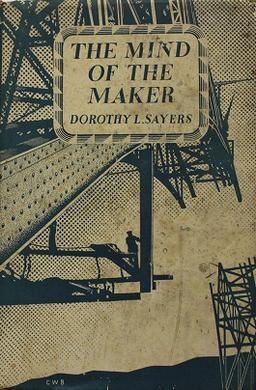 Dorothy L. Sayers: The Mind of the Maker (1941)
Dorothy L. Sayers: The Mind of the Maker (1941)•
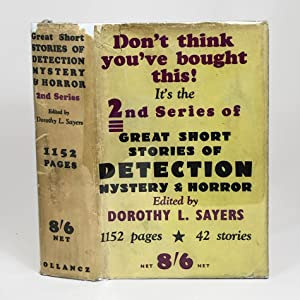 Dorothy L. Sayers, ed.: Great Stories of Detection, Mystery and Horror (Second Series: 1931)
Dorothy L. Sayers, ed.: Great Stories of Detection, Mystery and Horror (Second Series: 1931)Anthologist
I think that I've probably said enough above, in the first part of this post, to give you an idea of the effect that these three, brilliantly curated collections of the macabre have had on me, at least. Sayers also wrote a study of sensation novelist Wilkie Collins, which remained unpublished till long after her death, and there are enough references to occult maestro Sheridan Le Fanu in the Wimsey corpus to make it clear that he, too, was a subject of deep interest to her.
I guess that the overall point I wanted to make by piecing together these various disparate aspects of Sayers' ongoing influence was to point out how protean and fascinating her work remains. The same must, I suppose, be admitted of her life also, given the number of biographies and collections of letters which continue to appear.
Dismissing her as a detective writer with pretensions - or, worse, a thwarted scholar diverted into popular writing by poverty and circumstances - fails to explain why her books retain their vigour. Why, in short, do people continue to read them?
Part of it may be nostalgia for the (so-called) golden age of the detective genre, but Sayers' appeal goes far beyond that. Her characters are alive in a way that (say) Agatha Christie's or Edmund Crispin's - for all their technical ingenuity - are not.
Dorothy Sayers is, it appears, here to stay - and I, for one, am overjoyed to hear it.
•
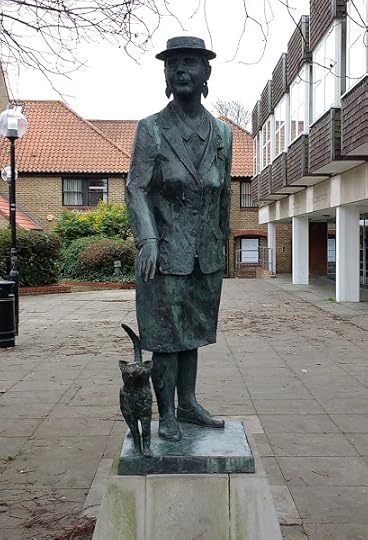 John Doubleday: Dorothy L. Sayers (2015)
John Doubleday: Dorothy L. Sayers (2015)Dorothy Leigh Sayers
(1893-1957)
Novels:
Whose Body? (1923)Included in: The Second Gollancz Detective Omnibus: Whose Body?, by Dorothy L. Sayers / The Weight of the Evidence, by Michael Innes / Holy Disorders, by Edmund Crispin. 1923, 1943 & 1945. London: Victor Gollancz Ltd., 1952.Whose Body? 1923. NEL Books. London: New English Library Limited, 1977. Clouds of Witness (1926)Included in: The Lord Peter Omnibus: Clouds of Witness / Unnatural Death / The Unpleasantness at the Bellona Club. 1926, 1927, 1928 & 1935. London: Victor Gollancz Ltd., 1964. Unnatural Death [aka The Dawson Pedigree] (1927)Included in: The Gollancz Detective Omnibus: The Moving Toyshop, by Edmund Crispin / Appleby’s End, by Michael Innes / Unnatural Death, by Dorothy L. Sayers. 1946, 1945 & 1927. London: Victor Gollancz Ltd., 1951.Included in: The Lord Peter Omnibus: Clouds of Witness / Unnatural Death / The Unpleasantness at the Bellona Club. 1926, 1927, 1928 & 1935. London: Victor Gollancz Ltd., 1964. The Unpleasantness at the Bellona Club (1928)Included in: The Lord Peter Omnibus: Clouds of Witness / Unnatural Death / The Unpleasantness at the Bellona Club. 1926, 1927, 1928 & 1935. London: Victor Gollancz Ltd., 1964. Strong Poison (1930)Included in: Three Great Lord Peter Novels: Strong Poison / Murder Must Advertise / The Nine Tailors. 1930, 1933 & 1934. London: Victor Gollancz Ltd., 1978. [with Robert Eustace] The Documents in the Case (1930)[with Robert Eustace] The Documents in the Case. 1930. London: Victor Gollancz Ltd., 1949. The Five Red Herrings [aka Suspicious Characters] (1931)The Five Red Herrings. 1931. London: Victor Gollancz Ltd., 1937. [with Members of The Detection Club: Canon Victor Whitechurch, George and Margaret Cole, Henry Wade, Agatha Christie, John Rhode, Milward Kennedy, Sayers, Ronald Knox, Freeman Wills Crofts, Edgar Jepson, Clemence Dane, Anthony Berkeley & G. K. Chesterton] The Floating Admiral (1931)Have His Carcase (1932)Have His Carcase. 1932. London: Victor Gollancz Ltd., 1935. Murder Must Advertise (1933)Murder Must Advertise: A Detective Story. 1933. London: Victor Gollancz Ltd., 1953.Included in: Three Great Lord Peter Novels: Strong Poison / Murder Must Advertise / The Nine Tailors. 1930, 1933 & 1934. London: Victor Gollancz Ltd., 1978. [With Members of The Detection Club: Anthony Berkeley, Milward Kennedy, Gladys Mitchell, John Rhode, Sayers & Helen Simpson] Ask a Policeman (1933)The Nine Tailors (1934)The Nine Tailors: Changes Rung on an Old Theme in Two Short Touches and Two Full Peals. 1934. London: Victor Gollancz Ltd., 1942.Included in: Three Great Lord Peter Novels: Strong Poison / Murder Must Advertise / The Nine Tailors. 1930, 1933 & 1934. London: Victor Gollancz Ltd., 1978. Gaudy Night (1935)Gaudy Night. 1935. London: Victor Gollancz Ltd., 1935. [With Members of The Detection Club: Margery Allingham, Anthony Berkeley, Freeman Wills Crofts, Father Ronald Knox, Sayers & Russell Thorndike] Six against the Yard (1936)Busman's Honeymoon: A Love Story With Detective Interruptions (1937)Busman's Honeymoon: A Love Story with Detective Interruptions. 1937. London: Victor Gollancz Ltd., 1949. [With Members of The Detection Club] Double Death: a Murder Story (1939)
Short Story Collections:
Lord Peter Views the Body (1928)Lord Peter Views the Body. 1928. London: Victor Gollancz Ltd., 1949. Hangman's Holiday (1933)Hangman's Holiday. 1933. NEL Books. London: New English Library Limited, 1978. [As Matthew Wimsey: with others] Papers Relating to the Family of Wimsey (1936)An Account of Lord Mortimer Wimsey, the Hermit of the Wash (1937)In the Teeth of the Evidence and Other Mysteries (1939)In the Teeth of the Evidence. 1939. NEL Books. London: New English Library Limited, 1973. The Wimsey Papers (1939-40)A Treasury of Sayers Stories (1958)Talboys [aka Striding Folly] (1972)Striding Folly: Including Three Final Lord Peter Wimsey Stories. Introduction by Janet Hitchman. 1972. NEL Books. London: New English Library Limited, n.d. Lord Peter: A Collection of All the Lord Peter Wimsey Stories (1972)The Wimsey Family: A Fragmentary History Compiled from Correspondence With Dorothy L. Sayers. Ed. C. W. Scott-Giles (1977)Scott-Giles, C. W. The Wimsey Family: A Fragmentary History Compiled from Correspondence with Dorothy L. Sayers. 1977. NEL Books. London: New English Library Limited, 1979. [With Members of The Detection Club] The Scoop and Behind the Screen [Radio playscripts, 1930 & 1931] (1983)[With Members of The Detection Club] Crime on the Coast and No Flowers by Request [Detective serials, 1953] (1984)The Complete Stories (2002)
Jill Paton Walsh (1937-2020) - Authorised Sequels:
[with Dorothy L. Sayers] Thrones, Dominations (1998)[with Dorothy L. Sayers] Thrones, Dominations. 1998. London: Hodder & Stoughton, 1998. [with Dorothy L. Sayers] A Presumption of Death (2002)[with Dorothy L. Sayers] A Presumption of Death: The New Lord Peter Wimsey Novel. 2002. A New English Library Paperback. London: Hodder & Stoughton, 2003. The Attenbury Emeralds (2010)The Late Scholar (2013)
Drama:
[with Basil Mason] The Silent Passenger [Screenplay] (1935)[with Muriel St. Clare Byrne] Busman's Honeymoon: A Detective Comedy in Three Acts (1936)The Zeal of Thy House (1938)Included in: Four Sacred Plays: The Devil to Pay / The Just Vengeance / He That Should Come / The Zeal of Thy House. London: Victor Gollancz Ltd., 1948. He That Should Come: A Nativity Play in One Act [Radio play] (1938)Included in: Four Sacred Plays: The Devil to Pay / The Just Vengeance / He That Should Come / The Zeal of Thy House. London: Victor Gollancz Ltd., 1948. The Devil to Pay: Being the Famous History of John Faustus, the Conjurer of Wittenberg in Germany: How He Sold His Immortal Soul to the Enemy of Mankind, and Was Served Twenty-four Years by Mephistopheles, and Obtained Helen of Troy to His Paramour, With Many Other Marvels; and How God Dealt With Him at the Last (1939)Included in: Four Sacred Plays: The Devil to Pay / The Just Vengeance / He That Should Come / The Zeal of Thy House. London: Victor Gollancz Ltd., 1948. Love All (1940)The Golden Cockerel: Adapted from Alexander Pushkin [Radio play] (1941)The Man Born to Be King: A Play-Cycle on the Life of Our Lord and Saviour Jesus Christ [Radio play] (1941-42)The Man Born to be King: A Play-Cycle on the Life of our Lord and Saviour Jesus Christ. Presented by the British Broadcasting Corporation, Dec. 1941–Oct. 1942. Producer: Val Gielgud. 1943. London: Victor Gollancz Ltd., 1946. The Just Vengeance (1946)Included in: Four Sacred Plays: The Devil to Pay / The Just Vengeance / He That Should Come / The Zeal of Thy House. London: Victor Gollancz Ltd., 1948. [With Members of The Detection Club] Where Do We Go From Here? [Radio play] (1948)The Emperor Constantine: A Chronicle (1951)
Non-fiction:
The Murder of Julia Wallace. In The Anatomy of Murder, by The Detection Club (1936)The Greatest Drama Ever Staged: Essays (1938)Strong Meat: Essays (1939)Begin Here: A War-Time Essay (1940)Creed or Chaos? and Other Essays in Popular Theology (1940)The Mind of the Maker: Essays (1941)The Mind of the Maker. 1941. London: Methuen & Co. Ltd., 1946. The Mysterious English (1941)Why Work? An Address Delivered at Eastbourne, April 23rd, 1942 (1942)The Other Six Deadly Sins: An Address Given to the Public Morality Council at Caxton Hall, Westminster, on October 23rd, 1941 (1943)Even the Parrot: Exemplary Conversations for Enlightened Children (1944)Making Sense of the Universe: An Address Given at the Kingsway Hall on Ash Wednesday, March 6th, 1946 (1946)Unpopular Opinions: Essays (1946)The Lost Tools of Learning (1948)The Days of Christ's Coming (1953)Introductory Papers on Dante (1954)The Story of Easter (1955)The Story of Noah's Ark (1956)Further Papers on Dante (1957)[with others] The Great Mystery of Life Hereafter (1957)The Poetry of Search and the Poetry of Statement, and Other Posthumous Essays on Literature, Religion, and Language (1963)Christian Letters to a Post-Christian World: A Selection of Essays. Ed. Roderick Jellema (1969)Are Women Human? Essays (1971)A Matter of Eternity: Selections From the Writings of Dorothy L. Sayers (1973)Wilkie Collins: A Critical and Biographical Study (1977)Spiritual Writings (1993)
Poetry:
Op. I (1916)Catholic Tales and Christian Songs (1918)Lord, I Thank Thee (1943)The Story of Adam and Christ (1955)
Translation:
Tristan in Brittany, Being Fragments of the Romance of Tristan, Written in the Twelfth Century by Thomas the Anglo-Norman (1929)The Heart of Stone, Being the Four Canzoni of the "Pietra" Group by Dante (1946)The "Comedy" of Dante Alighieri the Florentine. Cantica I: Hell (1949)Alighieri, Dante. The Comedy of Dante Alighieri the Florentine. Cantica I: Hell [L’Inferno]. Trans. Dorothy L. Sayers. 1949. Penguin Classics. Harmondsworth: Penguin, 1972. The "Comedy" of Dante Alighieri the Florentine. Cantica II: Purgatory (1955)Alighieri, Dante. The Comedy of Dante Alighieri the Florentine. Cantica II: Purgatory [Il Purgatorio]. Trans. Dorothy L. Sayers. 1955. Penguin Classics. Harmondsworth: Penguin, 1971. The Song of Roland (1957)The Song of Roland. 1957. Penguin Classics. Harmondsworth: Penguin, 1959. [with Barbara Reynolds] The "Comedy" of Dante Alighieri the Florentine. Cantica III: Paradise (1962)Alighieri, Dante. The Comedy of Dante Alighieri the Florentine. Cantica III: Paradise [Il Paradiso]. Trans. Dorothy L. Sayers & Barbara Reynolds. 1962. Penguin Classics. Harmondsworth: Penguin, 1971.
Edited:
[with Wilfred Rowland Childe & T. W. Earp] Oxford Poetry, 1917 (1918)[with T. W. Earp & E. F. A. Geach] Oxford Poetry, 1918 (1919)[with T. W. Earp & Siegfried Sassoon] Oxford Poetry, 1919 (1920)[with the Editorial Committee] The Quorum (1920)Great Short Stories of Detection, Mystery, and Horror (1928)Great Short Stories of Detection, Mystery and Horror. Part I: Detection and Mystery. 1928. London: Victor Gollancz, 1950.Great Short Stories of Detection, Mystery and Horror. Part II: Mystery and Horror. 1928. London: Victor Gollancz, 1951. Great Short Stories of Detection, Mystery, and Horror — Second Series (1931)Great Short Stories of Detection, Mystery and Horror. Part III: Detection and Mystery. 1931. London: Victor Gollancz, 1952.Great Short Stories of Detection, Mystery and Horror. Part IV: Mystery and Horror. 1931. London: Victor Gollancz, 1952. Great Short Stories of Detection, Mystery, and Horror — Third Series (1934)Great Short Stories of Detection, Mystery and Horror. Part V: Detection and Mystery. 1934. London: Victor Gollancz, 1952.Great Short Stories of Detection, Mystery and Horror. Part VI: Mystery and Horror. 1934. London: Victor Gollancz, 1952. Tales of Detection. Everyman's Library (1936)
Letters:
The Letters of Dorothy L. Sayers: 1899–1936: The Making of a Detective Novelist (1995)The Letters of Dorothy L. Sayers: 1937–1943, From Novelist to Playwright (1998)The Letters of Dorothy L. Sayers: 1944–1950, A Noble Daring (1999)The Letters of Dorothy L. Sayers: 1951–1957, In the Midst of Life (2000)The Letters of Dorothy L. Sayers: Child and Woman of Her Time - A Supplement to the Letters (2002)
Secondary:
Hitchman, Janet. ‘Such a Strange Lady’: An Introduction to Dorothy L. Sayers (1893-1957). 1975. NEL Books. London: New English Library Limited, 1979.Brabazon, James. Dorothy L. Sayers: A Biography. Preface by Anthony Fleming. Foreword by P. D. James. 1981. A Discus Book. New York: Avon Books, 1982.Dale, Alzina Stone. Maker and Craftsman: The Story of Dorothy L. Sayers (1993)Reynolds, Barbara. Dorothy L. Sayers: Her Life and Soul (1993)Duriez, Colin. Dorothy L Sayers: A Biography - Death, Dante and Lord Peter Wimsey (2021)
•
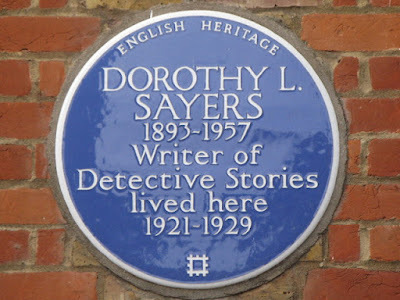 English Heritage Blue Plaque: 23 & 24 Great James Street, WC1 (London)
English Heritage Blue Plaque: 23 & 24 Great James Street, WC1 (London)
Published on July 31, 2022 13:17
July 16, 2022
The Gold Bug
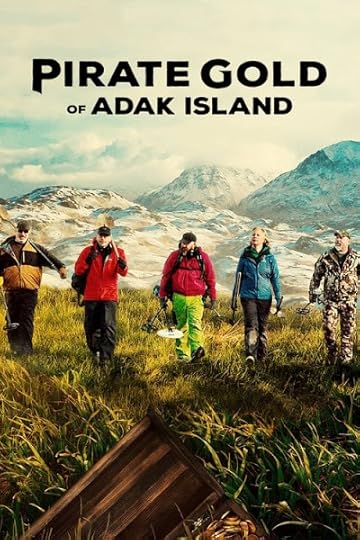 Netflix: Pirate Gold of Adak Island (2022)
Netflix: Pirate Gold of Adak Island (2022)[Warning: numerous plot-spoilers ahead]
Recently I've been beguiling my leisure by watching the reality TV show pictured above. Would I recommend it? Not really. There are moments when the cast seem literally to find solace in gathering around their truck watching paint dry, and their most exciting cliffhangers generally turn out to be disappointments.
By far the most thrilling event to date has been the explosion of some abandoned WWII ordinance by a visiting explosives expert, but even this failed to turn up anything faintly resembling treasure - unless you count old bale-hooks or discarded drink cans.
But then, that's pretty much what I expected coming in. I guess what amazes me is the extent to which people are still fascinated by the lure of gold - finding it, digging it up, panning for it ... You name it, there's a reality series devoted to it.
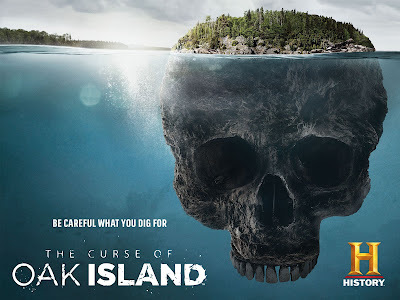 Kevin Burns: The Curse of Oak Island (2014- )
Kevin Burns: The Curse of Oak Island (2014- )The resonantly titled Pirate Gold of Adak Island comes hot on the heels of the even more tedious (to unbelievers, that is) Curse of Oak Island. I have to confess that when I first ran across the story of the treasure of Oak Island, in a collection of articles from British magazine The Unexplained (1980-83), I found it quite beguiling. In fact I even used it as the frame for a short story ("The Money Pit", 2004). This is how my story began:
 Jack Ross: Monkey Miss Her Now (2004)
Jack Ross: Monkey Miss Her Now (2004)One fine summer’s day in 1795, a sixteen-year-old boy named Daniel McGinnis rowed over to a small island called Oak Island, off the coast of Canada. He hadn’t been there long when he noticed a track leading inland. He followed it, and found a little clearing with an oak tree at the centre. There was a depression in the ground beside it, and marks of ropes and pulleys on the trunk.
Next day he came back with two friends, and started to dig for the buried treasure they thought must be hidden there. Four feet down, they found a layer of flagstones, which persuaded them they were onto something. At ten feet, they found a layer of oak logs. At 20 feet, more oak logs. At 30, still more. That was as far as they could get by themselves, so they went back to town to try and raise money to dig further.
No-one seemed very interested in their project, so it wasn’t till 1804, ten years later, that they were able to return with the equipment to dig deeper. At 40 feet, they found another layer of oak logs, sealed with putty. Then there was a layer of charcoal, then more logs at 50 feet, 60 feet, 70 feet and 80 feet. At 90 feet they found a stone with strange writing on it, but none of them could read it, so they just kept on digging. By now the ground was very wet, and they were continuously bailing out water. At 98 feet they found a platform of spruce logs, and decided that the treasure must be hidden underneath. It was late on a Friday, though, and they decided to leave the last few feet for Monday morning.
On Monday, when they got back to the island, they found the entire pit flooded with water from about thirty feet down. There was nothing more they could do, so they were forced to leave behind whatever was buried there.
This was just the first of many attempts to excavate the “Money Pit” and decipher the mystery of Oak Island. Each new group who came to dig there messed the ground up more, making it more and more difficult to reconstruct the original arrangements.
Eventually they discovered there were tunnels leading to the pit from the nearby seashore, which is why it flooded at every high tide. As the mine shafts got deeper and deeper, the ground got more and more sodden with water, which is why nobody could ever follow up drills which seemed to touch metal objects down in the darkness.
To this day, nobody has succeeded in discovering just what was hidden at the bottom of this mysterious deep hole in the ground. In 1970 a special submarine camera was sent down over 200 feet. It filmed what looked like a treasure chest with a severed hand beside it. Divers were unable to find anything there, though.
Nobody knows who dug the immense pit – or why.B(-). This is an interesting story, which you tell very well, but I wonder why it’s of significance to you, and what it tells you as a story? (I take it it’s true and not invented?) You might have included some character sketches of the main people involved, or some theories about who dug the hole (Pirates? Spacemen?) It isn’t really a history essay otherwise, I’m afraid, and can’t be seen as an answer to the question about the nineteenth-century event which seems most significant to you.
After this opening preamble the presumed author of the essay, Laura, a high-school student who reappears in the novella Trouble in Mind, moves on to somewhere else "in time, space, or language", as Roger Horrocks puts it in his blurb above. It does provide a useful summary of the core story of Oak Island and its mysterious money pit, however.
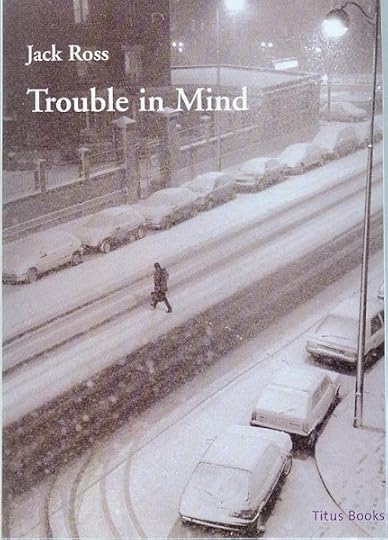 Jack Ross: Trouble in Mind (2005)
Jack Ross: Trouble in Mind (2005)You can guess, then, how enthusiastically I watched the first episodes of The Curse of Oak Island when they first reached local TV! Here at last was a chance to see the island itself, not to mention the fabled money pit which had for so long haunted my dreams ...
Only to find a farrago of deserted building sites, endless discussions in boring, ill-lit rooms, loud arguments between men in caps on grimy beaches - and more of the usual stuff of reality TV. It seems unbelievable to me that the quest continues, after (now) nine annual seasons of almost completely uneventful treasure hunting.
I guess, in the end, the ultimate treasure is ratings, and if you can persuade your audience to keep on tuning in, then that's where the money is.
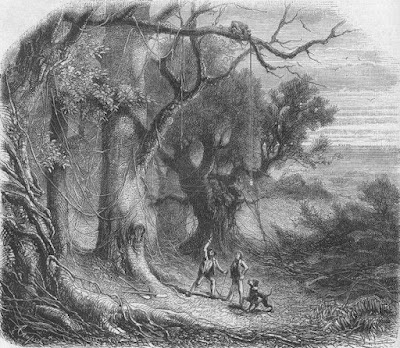 Edgar Allan Poe: The Gold-Bug (1843)
Edgar Allan Poe: The Gold-Bug (1843)The great grand-daddy of such shows would have to be Edgar Allan Poe's story "The Gold-Bug." The whole apparatus of secret codes, hidden clues, and picturesque adventures on the way to treasure is deployed here in full for virtually the first time.
The Sherlock Holmes story "The Dancing Men" finds its origins here, as indeed does the use of such crypto- and cartographic devices in fiction. Poe may not have invented Science Fiction itself (the credit for that is now generally awarded to Mary Shelley's Frankenstein), but he does have a strong claim to be regarded as the progenitor of its close cousin, Detective Fiction.
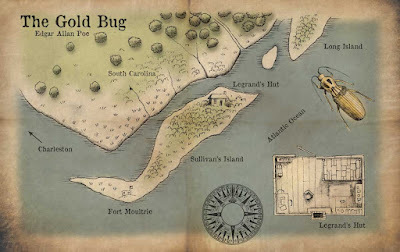 S. S.: The Gold-Bug (blendspace)
S. S.: The Gold-Bug (blendspace)"The Gold-Bug" remains one of Poe's most popular stories. The ingenuity of the plot is equal to any of his earlier tales of Dupin, and the pirate-gold motif (left behind, on this occasion, by no less a figure than Captain Kidd himself) directly inspired such works as Stevenson's (1883), Rider Haggard's King Solomon's Mines (1885), and thus, obliquely, J. M. Barrie's Peter Pan (1904).
 John Huston, dir.: The Treasure of the Sierra Madre (1948)
John Huston, dir.: The Treasure of the Sierra Madre (1948)There is, however, an alternate tradition. The mysterious B. Traven's novel The Treasure of the Sierra Madre (1927) was made into an even more famous film by John Huston in 1948. In one of his greatest performances, Humphrey Bogart embodied hopeless drifter Fred C. Dobbs, lured by greed for gold into a homicidal frenzy, until he's finally cornered by a posse of Mexican bandidos.
The film's last image, of gold dust blowing away in the desert wind, aptly sums up its message: Beware! Beware of gold-fever, of excessive greed, of dying alone with your inedible treasure all around you ...
Much the same could be said of Captain Gregory Dwargstof, the seal-poaching pirate reputed to have buried a fortune in gold coins on Adak Island in 1892. After stashing away his ill-gotten gains, it's revealed in the reality series that his ship was wrecked in the Aleutian Islands, and that he himself was imprisoned by the Tsarist authorities, only to die a few months later without ever revealing the location of his hoard.
Having watched (now) what seems like hours of our ill-assorted cast of 'expert' treasure-hunters digging vague holes in the tundra in pursuit of ever more outlandish theories about just where Dwargstof would have left it, or must have left it, or might conceivably have left it, it's hard for me to feel too much confidence in their ultimate success.
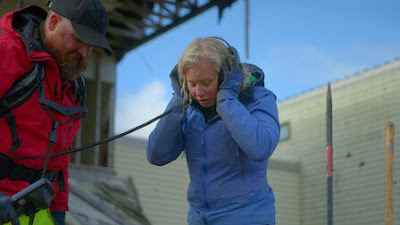 l-to-r: Brian Weed & Dr. M. Jackson
l-to-r: Brian Weed & Dr. M. JacksonAnd yet, they are in many ways a rather endearing group. There's the ever optimistic 'Doctor M.', whose scientific acumen seems to entitle her mainly to do most of the digging while the men stand around and watch, or else swing their metal detectors in vague circles to encourage her efforts.
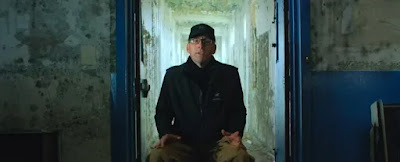 Thom Spitler
Thom SpitlerThen there's the intrepid Mayor of Adak Island, Thom Spitler, a steely-eyed mountain man capable of either detecting unexploded shells or leading rescue missions in the hills with equally insouciant efficiency. The real surprise of the series is that he needs any assistance from the others at all.
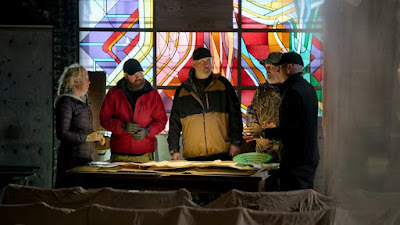 l-to-r: Dr. M. Jackson, Brian Weed, Jay Toomoth, Burke Mitchell & Thom Spitler
l-to-r: Dr. M. Jackson, Brian Weed, Jay Toomoth, Burke Mitchell & Thom Spitler Then there are Burke and Jay, a pair of childhood friends who grew up near the military base on Adak Island, and have a nostalgic attachment to its deserted ruins. While they do seem at times to be longer on bluster than on technical ability, you have to give them credit for constructing some pretty impressive bomb-shielding and rock-lifting gear from random scraps of metal.
The same might be said of technician Brian Weed, who wrangles some wonderfully futuristic gear which seldom seems to detect anything useful.
Despite all my doubts and reservations, though, I have to admit that the series does culminate in an admirably built-up-to climax, which may even succeed in earning them a second bite at the cherry. And, after all, the scenery and atmosphere of the almost abandoned island, with its old rows of prefabs and rain-sodden hall of records, is probably worth the price of admission on its own.
 Brant Parker & Johnny Hart: The Wizard of Id
Brant Parker & Johnny Hart: The Wizard of IdWhat, then, is one to conclude? That the lure of gold is stronger than any of the excellent reasons other people can come up with to divert your energies elsewhere? That Jack London, Bret Harte, Mark Twain, B. Traven, and all the others wrote their tales of the ignus fatuus of the goldfields in vain?
Yep, pretty much. So long as suckers such as myself continue to watch programmes such as The Curse of Oak Island , Gold Rush , Aussie Gold Hunters and now Pirate Gold of Adak Island , the temptation to cash in on the gold bug will remain.
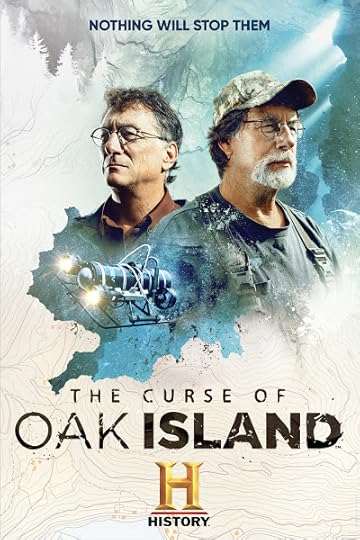 Rick and Marty Lagina: The Curse of Oak Island
Rick and Marty Lagina: The Curse of Oak Island•
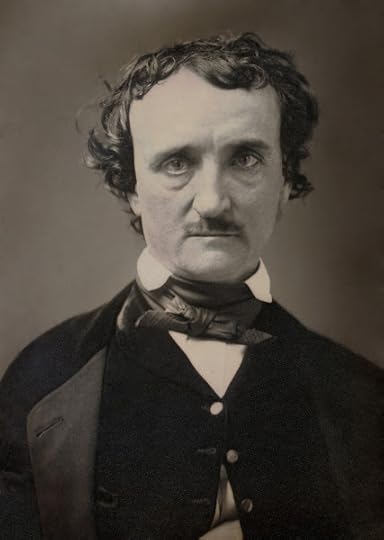 Edgar Allan Poe (1849)
Edgar Allan Poe (1849)Edgar Allan Poe
(1809-1849)
Poetry:
[as 'a Bostonian'] Tamerlane and Other Poems (1827)Al Aaraaf, Tamerlane and Minor Poems (1829)Poems (1831)The Raven and Other Poems (1845)The Poems of Edgar Allan Poe, ed. Floyd Stovall (1965)
Prose:
The Narrative of Arthur Gordon Pym of Nantucket (1838)Les Aventures d'Arthur Gordon Pym de Nantucket. Trans. Charles Baudelaire (1858)The Narrative of Arthur Gordon Pym of Nantucket. Edited with an Introduction and Commentary, Including Jules Verne’s Sequel Le Sphinx des Glaces. 1838 & 1897. Ed. Harold Beaver. 1975. The Penguin English Library. Harmondsworth: Penguin, 1980. Tales of the Grotesque and Arabesque (1840)The Prose Romances of Edgar A. Poe (1843)Tales (1845)Eureka: A Prose Poem (1848)Histoires Extraordinaires. Trans. Charles Baudelaire (1856)Histoires Extraordinaires. Trans. Charles Baudelaire. 1856. Préface de Julio Cortázar. Collection Folio, 310. Paris: Éditions Gallimard, 1973. Nouvelles Histoires Extraordinaires. Trans. Charles Baudelaire (1857)Histoires grotesques et sérieuses. Trans. Charles Baudelaire (1864)Tales of Mystery and Imagination. Illustrated by Arthur Rackham. 1935. London: Octopus Books Limited, 1986.The Science Fiction of Edgar Allan Poe. Ed. Harold Beaver. 1976. The Penguin English Library. Harmondsworth: Penguin, 1977.The Short Fiction of Edgar Allan Poe: An Annotated Edition. Ed. Stuart & Susan Levine. Bobbs-Merrill Educational Publishing. Indianapolis: The Bobbs-Merrill Company, Inc., 1977.The Other Poe: Comedies and Satires. Ed. David Galloway. The Penguin American Library. Ed. John Seelye. Harmondsworth: Penguin, 1983.
Collections:
The Works of the Late Edgar Allan Poe. 4 vols. Ed. Rufus Wilmot Griswold (1850-56)The Complete Works of Edgar Allan Poe. 17 vols. Ed. James A. Harrison (1902)The Complete Tales and Poems. Introduction by Hervey Allen. The Modern Library of the World’s Best Books. New York: Random House, Inc., 1938.Selected Writings: Poems, Tales, Essays and Reviews. Ed. David Galloway. 1967. The Penguin English Library. Harmondsworth: Penguin, 1970.Collected Works of Edgar Allan Poe. 3 vols. Ed. Thomas Ollive Mabbott (1969 & 1978)Poetry and Tales. Ed. Patrick F. Quinn. The Library of America, 19. New York: Literary Classics of the United States, Inc., 1984.Essays and Reviews. Ed. G. R. Thompson. The Library of America, 20. New York: Literary Classics of the United States, Inc., 1984.Collected Stories and Poems. Illustrated by Aubrey Beardsley, Harry Clarke, Gustave Doré, Edouard Manet, & John Tenniel. London: CRW Publishing Ltd., 2006.
Secondary:
Symons, Julian. The Tell-tale Heart: The Life and Works of Edgar Allan Poe. 1978. Harmondsworth: Penguin, 1981.
•
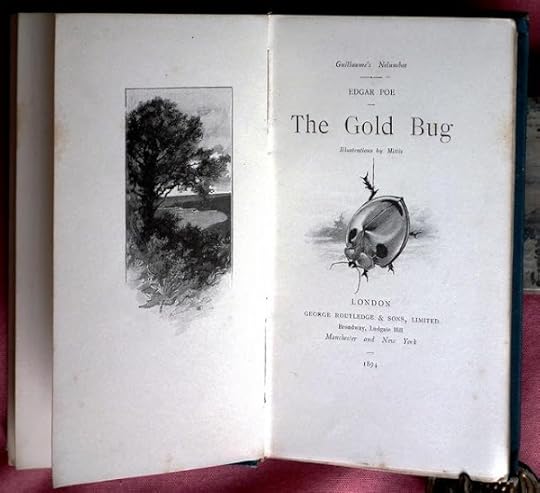 Edgar Allan Poe: The Gold-Bug. Illustrations by Mittis (1894)
Edgar Allan Poe: The Gold-Bug. Illustrations by Mittis (1894)
Published on July 16, 2022 14:32
June 25, 2022
Rereading Old Children's Books
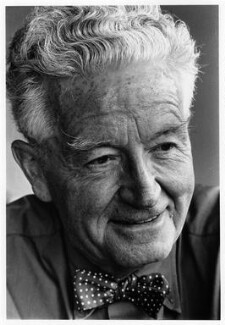 Bryan Wharton: John Sleigh Pudney (1967)
Bryan Wharton: John Sleigh Pudney (1967)In his last few years, just about the only thing my father seemed to want to read were old children's books by the likes of Laurence R. Bourne and Percy F. Westerman, as well as 'Biggles', the 'Swallows and Amazons' series, and the school stories and adventure serials in his almost complete sets of Chums and the Boys Own Annual .
 Percy F. Westerman: The Bulldog Breed (c.1930s)
Percy F. Westerman: The Bulldog Breed (c.1930s)"Resting the tired brain," he would call it. They were large books, printed on thick newsprint, with garish cover pictures, and they eventually occupied most of the bookcases in the house - relegating my mother's collection of Jane Austen, George Eliot, and other school-prize classics to the ever-growing rows of cardboard boxes in the basement.
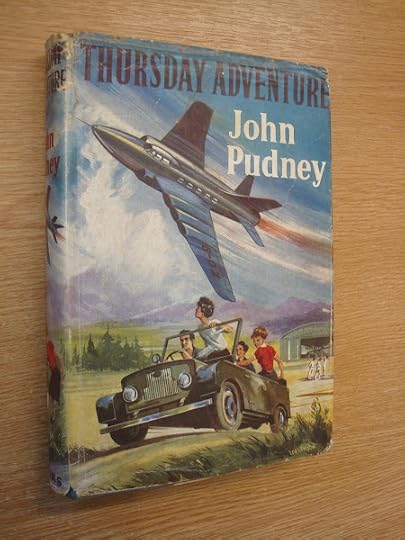 John Pudney: Thursday Adventure (1955)
John Pudney: Thursday Adventure (1955)I was thinking of him the other day when I ran across a battered ex-library copy of John Pudney's Thursday Adventure in a Hospice Shop. I'd never read it before, but our family collection did include various other instalments in the cycle of "Fred and I" adventures: entitled variously 'Saturday', 'Sunday', 'Monday' Adventure - and so on through all the days of the week. There was even a coda of 'Spring', 'Summer' (and so on) seasonal Adventures.
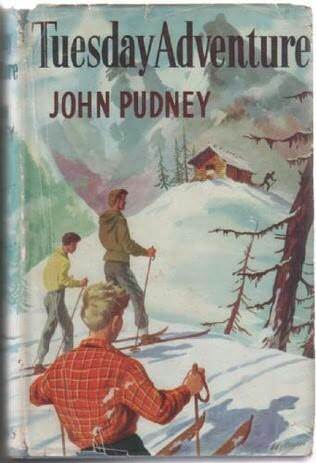 John Pudney: Tuesday Adventure (1953)
John Pudney: Tuesday Adventure (1953)The one I remember best was, I think, Tuesday Adventure. At any rate, the plot summary for that one included on the flyleaf of Thursday Adventure definitely rings a bell. I remember thinking it wonderfully imaginative and exciting at the time: it has some mildly Science Fictional elements in it, as do the other volumes, hence the inclusion of its author, John Pudney, in the Encyclopedia of Science Fiction database.
For years I'd had in the back of my mind the desirability of acquiring a complete set of these books, days and seasons alike, all 11 of them - perhaps even deducing the hinted-at identity of "I", the narrator of the stories. Is "I" in fact a boy at all? And is Fred "I's" brother, or cousin, or what? For that matter, is "Uncle George" a real relative, or just a family friend?
 John Sharp, dir.: The Stolen Airliner (1955)
John Sharp, dir.: The Stolen Airliner (1955)Now I'm not so sure. Thursday Adventure, despite being the only one in the series to be filmed - as The Stolen Airliner - doesn't evoke quite the same feelings I expected it to. The storytelling seems a little on the perfunctory side, the heroes and villains too neatly lined up for our inspection from the kick-off.
Perhaps if I'd been able to read it when I was younger it might be different. Lord knows I wanted to - but our school library was sadly lacking in thrillers. But I'll always be grateful for those few unobtrusive SF anthologies it included.
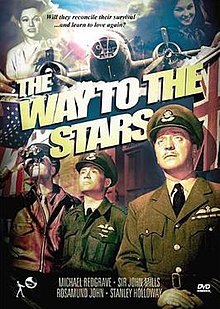 Anthony Asquith, dir.: The Way to the Stars (1945)
Anthony Asquith, dir.: The Way to the Stars (1945)Though I didn't realise it at the time, John Pudney was a far more versatile and interesting figure than he seemed. As a slightly younger contemporary of W. H. Auden, he'd published a number of poetry books on the fringes of the Macspaunday group in the thirties before finding his true audience in the forties as a war writer.
The Way to the Stars, pictured above, is famous for containing two poems by Pudney which are implied, in context, to have been written by Michael Redgrave's character in the movie: "Missing" and "Johnny-head-in-air." The latter, in particular, became a kind of R.A.F. anthem:
Do not despair
For Johnny-head-in-air;
He sleeps as sound
As Johnny underground.
Fetch out no shroud
For Johnny-in-the-cloud;
And keep your tears
For him in after years.
Better by far
For Johnny-the-bright-star,
To keep your head
And see his children fed.
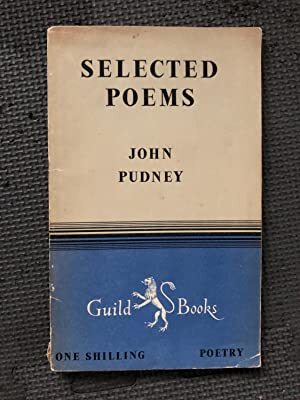 John Pudney: Selected Poems (1946)
John Pudney: Selected Poems (1946)It was probably on the strength of this that his Selected Poems was published as a mass-market paperback in 1946.
His subsequent career as a hard-working journalist was punctuated by two sets of children's books, The "Fred and I" series mentioned above, and the "Hartwarp" series (for younger readers) in the 1960s. He also wrote a number of other novels and stories, though his main source of income appears to have been the non-fiction works he was commissioned to write, especially those on aeronautical subjects.
He was also an alcoholic. His eventual success in overcoming this habit forms the principal subject of much of his later verse, particularly that included in his second volume of Selected Poems, which I also own:
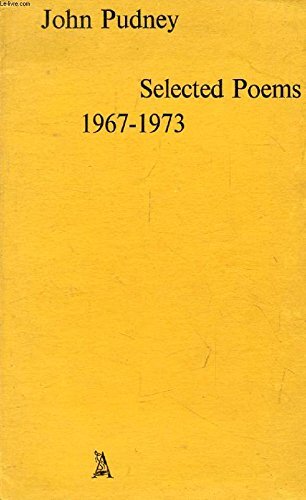 John Pudney: Selected Poems 1967-1973 (1973)
John Pudney: Selected Poems 1967-1973 (1973)What of it? you may say. He had his day; his "sins were scarlet but his books were read" (as Hilaire Belloc once put it). Is there any real need to resurrect him now? I suppose that I'd hoped "Fred and I" would retain the fascination they held for me as a pre-teen, but they don't, not really.
I don't regret making the experiment, though. It's true that we did feel at the time that my father was disappearing down a rabbit-hole of infantile fiction, dedicated principally (it seemed) to brave boys upholding the values of the British Empire against posturing Prussians, bloodthirsty Bolsheviks, and rebellious natives.
The other main thing he read was history, though, and the essentially tragic nature of that long chronicle of "old unhappy things and battles long ago" perhaps justified his predilection for the less testing pleasures of boy's literature.
I, too, now find myself reading old children's books both for relaxation and for the window they supply on the values of even the comparatively recent past. The "Bannermere" books of self-conscious leftist Geoffrey Trease, for instance, may seem fearfully buttoned-up and tame nowadays, but when they they were written - at much the same time as John Pudney's "Fred and I" stories - they definitely constituted a reaction agains the "landed gentry" assumptions of earlier children's fiction.
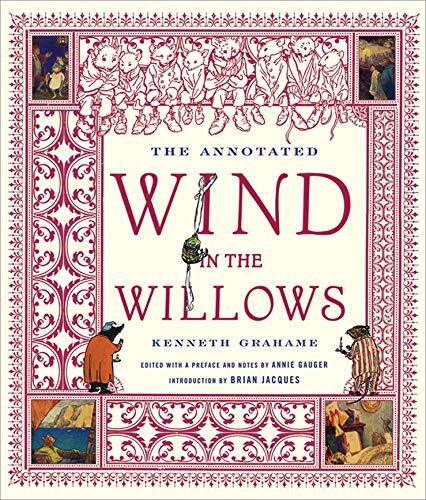 Annie Gauger, ed.: The Annotated Wind in the Willows (2009)
Annie Gauger, ed.: The Annotated Wind in the Willows (2009)Much though I love Kenneth Grahame's Wind in the Willows, for instance, it's hard not to concur with my old Edinburgh Professor Wallace Robson's classic analysis of the class values that underlie it: the proletarian weasels' attempt to encroach on the inherited domains of Toad, the local squire, who has to be upheld by our heroes, Mole, Rat and Badger, despite their own contempt for Toad's foolish and criminal antics.
There's a lot to be learned, then, from children's books. It would have to be admitted that they can constitute an insidious form of brainwashing for the precociously literate. But the values of heroism, self-reliance, and refusal to kowtow to bullies encoded in most of them, regardless of fashion or era, should surely not be despised then or now?
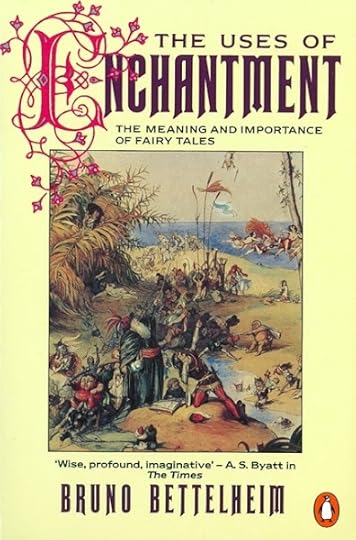 Bruno Bettelheim: The Uses of Enchantment (1976)
Bruno Bettelheim: The Uses of Enchantment (1976)So I'll continue to collect and read them despite my occasional misgivings. There's some shocking stuff in some of them, I would acknowledge, but sheltering your mind from any views contrary to your own is not really much of a recipe for continued mental health.
I've always felt there was a lot in Nazi concentration camp survivor Bruno Bettelheim's claim of the continuing value of the shockingly violent and disruptive world of Grimm's fairytales, despite the understandable reluctance of many contemporary parents to expose their children to this barbarous world of ravening monsters and arbitrary power.
The goalposts may shift from era to era, but the need to think your own thoughts, defend your own values, and stand up for what you believe in lies deep at the heart of all the great works of children's literature from Lewis Carroll's Alice to Philip Pullman's Lyra books.
Children who don't read at all are in much greater danger of falling for charlatans than those who've imbibed copious doses of fairytales and beast fables at a formative age.
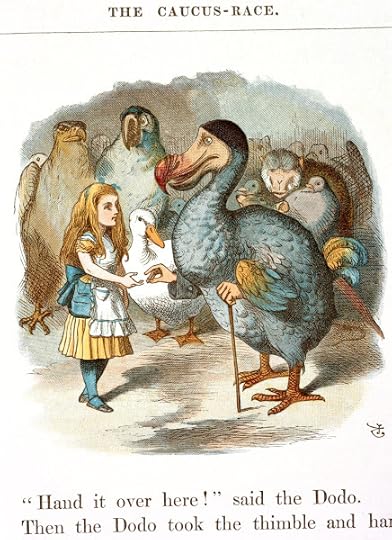 John Tenniel: The Nursery Alice (1890)
John Tenniel: The Nursery Alice (1890)
Published on June 25, 2022 15:08
May 31, 2022
My New Bookcase
 Bibliography / Psychogeography Bookcase
Bibliography / Psychogeography Bookcase[photographs by Bronwyn Lloyd (1/6/22)]
Bronwyn and I are inveterate vintage shoppers. The other day we were looking through the Hospice shop at Wairau Park (located just up the street from Hoyts Cinemas, enabling one to combine browsing with moviegoing in a very civilised fashion). In the past she's been a bit scornful of my tendency to return from such expeditions with a pile of scruffy old ex-library books, so I was quite surprised when she pointed out a handsome wooden bookcase in the middle of the shop.
 Wairau Park Hospice Shop (2020)
Wairau Park Hospice Shop (2020)Or, rather, there were two bookcases. One was so large and imposing that it was hard to imagine fitting it into our remaining free wallspace. However the other, smaller one had tall, wide, wooden shelves, and looked tailor-made to hold some exciting new category of books.
The last time an event of this type happened, I used the new space to centralise my previously disparate collection of ghost stories. This time I decided to tackle the tricky topic of psychogeography.
But what exactly is psychogeography? I suppose, in the final analysis, it mainly depends on the list of authors you choose to attach to the concept. I wrote some notes about it for one of our Massey postgraduate creative writing courses a few years ago, which I'll refer you to if you want to explore the theme in more depth. I'll content myself here with a brief précis:
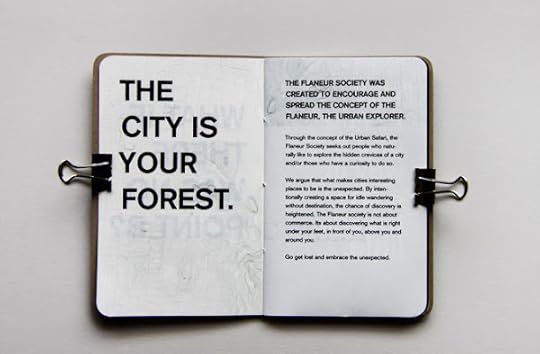 Richard Edkins: The Flâneur, Psychogeography and Drift Photography (2015)
Richard Edkins: The Flâneur, Psychogeography and Drift Photography (2015)Not to find one’s way in a city may well be uninteresting and banal. It requires ignorance — nothing more. But to lose oneself in a city — as one loses oneself in a forest — that calls for a quite different schooling. Then, signboard and street names, passers-by, roofs, kiosks, or bars must speak to the wanderer like a cracking twig under his feet in the forest. - Walter Benjamin, A Berlin Chronicle (1932)
In many ways, psychogeography could be seen as a revival of French poet Charles Baudelaire's idea of the flâneur, the perambulating dandy, whose apparently aimless wanderings offer vital clues to the deeper meaning of modern urban environments.
Psychogeography continues to be associated principally with urban explorations - Peter Ackroyd's double-focus historical novel Hawksmoor (1985); Mike Davis's City of Quartz: Excavating the Future in Los Angeles (1990); Alan Moore's graphic novel From Hell (1989-99), which postulates a Masonic "secret history" behind the Jack the Ripper murders; and Iain Sinclair's explorations of London's mythic past and present in such works as Lights out for the Territory: 9 Excursions in the Secret History of London (1997) - even Chris Trotter's chapter about an idealised dream Auckland in his alternative history of New Zealand No Left Turn (2007).
However, in his more recent book the Edge of the Orison (2005), Sinclair has extended his methodology to cover the rural haunts of nineteenth-century English nature poet John Clare, setting out to retrace the poet's famous 'Journey out of Essex' - Clare's own prose account of his 1841 escape from the asylum in which he had been incarcerated to find his lost love, Mary Joyce (unfortunately already three years dead).
Psychogeography, then, deals principally with boundary-crossings: whether those boundaries are those of genre (verse, fiction, non-fictional prose) or discipline (history, geography, travel, memoir and biography).
I suppose, in essence, that it consists of imposing a theory (generally of an occult or abstruse nature) on a landscape, more or less arbitrarily. The landscape is then interrogated to see whether or not it matches up with or confirms the theory, no matter how - intentionally - absurd it may be.
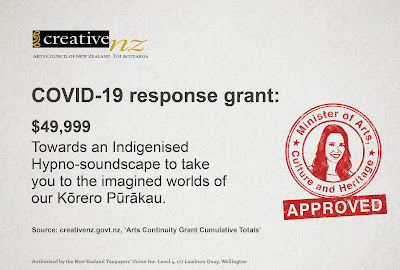 Creative NZ grants (2020)
Creative NZ grants (2020)The list of notable psychogeographers included in Wikipedia's article on the subject includes the following names:
Peter AckroydMichèle BernsteinPat BarkerPaul ConneallyGuy DebordStewart HomeJacqueline de JongRobert MacfarlaneGeoff NicholsonIain SinclairLaura Oldfield FordNick PapadimitriouWill SelfCathy Turner (artist)Jean RolinPhilippe Vasset
My own set of favourite psychogeographers is far shorter, though it does include a few of the same suspects:
(1923-2022) (1793-1864) (1952- ) (1944-2001) (1943- )
•
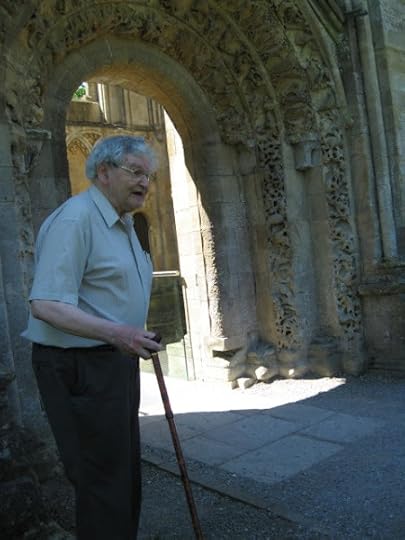 Geoffrey Ashe (2009)
Geoffrey Ashe (2009)& the Arthurian Legend
Geoffrey Ashe actually died just a couple of months ago, on the 30th January 2022, at his home in Glastonbury. On my one and only visit there, in 1981, I was hugely impressed by the intense atmosphere projected by both the town and its environs. I had, admittedly, been reading John Cowper Powys' mammoth novel A Glastonbury Romance, and a combination of that and Geoffrey Ashe's King Arthur's Avalon made it seem like holy ground to me.
I remember dashing up Glastonbury Tor, and feeling as though the ghosts were springing out of the grass all around me. Until my father turned to make some banal remark, that is - God knows how he put up with such a sullen and pretentious teen! All I can say is that my siblings weren't much better. "Thanks for the interruption," as one of my older brothers remarked on a not dissimilar occasion.
The Arthurian legend could certainly be described as England's Dreaming (the title of Jon Savage's classic book about the Sex Pistols). There are rivals, of course: Robin Hood and his Merry Men, Langland's peasant hero Piers Plowman - but only King Arthur's aristocratic mythos combines all the different strands of Celtic, Roman, Saxon, and Norman culture into one bizarre cauldron of stories.
Here's a selection of some of the literature on the topic I've collected over the years. First, from Geoffrey Ashe's own eclectic bibliography (you can find out more about him from my blogpost on the subject):

King Arthur’s Avalon: The Story of Glastonbury. 1957. Fontana Books. London: Collins, 1973.From Caesar to Arthur. London: Collins, 1960.Land to the West: St Brendan’s Voyage to America. London: Collins, 1962.All About King Arthur. 1969. London: Carousel Books, 1973.Camelot and the Vision of Albion. 1971. St. Albans, Herts: Panther, 1975.The Finger and the Moon. 1973. St. Albans, Herts: Panther, 1975.The Virgin. 1976. Paladin. Frogmore, St Albans, Herts: Granada Publishing Limited, 1977. The Ancient Wisdom. 1977. Abacus. London: Sphere Books, 1979. Avalonian Quest. 1982. London: Fontana Paperbacks, 1984. The Discovery of King Arthur. With Debrett’s Peerage. London: Guild Publishing, 1985.The Landscape of King Arthur. With Photographs by Simon McBride. London: Webb & Bower (Publishers) Limited, in association with Michael Joseph Limited, 1987.Mythology of the British Isles. 1990. London: Methuen London, 1992.I've added a few other books to the bookcase to contextualise Ashe's curious imaginings. He was a strange combination of scholar and visionary, and - at least until the 'psychogeographer' label came along - it was hard to work out which of these aspects was the most dominant: Alcock, Leslie. Arthur’s Britain: History and Archaeology, AD 367-634. 1971. A Pelican Book. Harmondsworth: Penguin, 1973.Ashe, Geoffrey, ed. The Quest for Arthur’s Britain. With Leslie Alcock, C. A Ralegh Radford, & Philip Rahtz. 1968. London: Paladin, 1973.Barber, Richard. Legends of King Arthur. The Boydell Press. Woodbridge, Suffolk: Boydell & Brewer Ltd., 2001.Barber, Richard. The Holy Grail: The History of a Legend. 2004. Harmondsworth: Penguin, 2005.Bord, Janet & Colin. Mysterious Britain. 1972. A Paladin Book. Frogmore, St Albans: Granada Publishing Ltd., 1975.Chambers, E. K. Arthur of Britain. London: Sidgwick & Jackson, Ltd., 1927.Geoffrey of Monmouth. The History of the Kings of Britain. Trans. Lewis Thorpe. 1966. Penguin Classics. Harmondsworth: Penguin, 1976.Gerald of Wales. The History and Topography of Ireland. Trans. John J. O’Meara. 1951. Penguin Classics. Harmondsworth: Penguin, 1982.Cambrensis, Giraldus. The Itinerary through Wales and The Description of Wales. Trans. Sir Richard Colt Hoare. 1806. Introduction by W. Llewellyn Williams. 1908. Everyman’s Library. London: J. M. Dent & Sons Ltd. / New York: E. P. Dutton & Co. Inc., n.d.Treharne, R. F. The Glastonbury Legends. 1967. Abacus. London: Sphere Books, Ltd., 1975.Watkins, Alfred. The Old Straight Track. 1925. London: Abacus, 1976.Weston, Jessie L. From Ritual to Romance. 1920. New York: Doubleday Anchor Books, 1957.
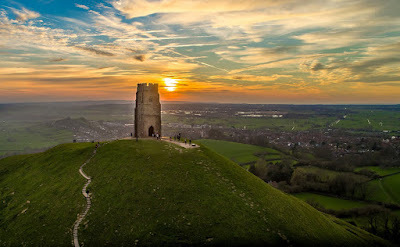 Joanna Gillan: Glastonbury Tor (2022)
Joanna Gillan: Glastonbury Tor (2022)•
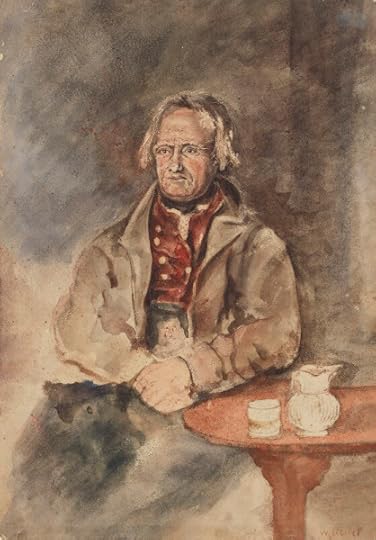 William Henry Hunt: Unknown Man (perhaps John Clare?) (1820s)
William Henry Hunt: Unknown Man (perhaps John Clare?) (1820s)& the Power of Pastoral
I've written a couple of posts about John Clare already. The first was an attempt to parallel his poetic practice with that of his near-contemporary Charles Baudelaire. The second was more narrowly focussed on the peculiarities of his bibliography.
He's one of those poets you either get or you don't. His 'madness' (i.e. inability to conform) has made him a troublesome figure for readers and literary scholars alike. In his lifetime his poems were normalised and repunctuated for him by his publisher. After his death the same service has been performed by a series of editors.
But then, the same could be said of almost all the poets of his era. Wordsworth himself punctuated oddly and sporadically, expecting his printers to deal with such accidentals. Even W. B. Yeats was notoriously vague about both spelling and 'stops'.
But Clare is in a class of his own. His output was vast and disorderly - especially the later poems from the asylum years. What makes him an appropriate figure to include here is the immense precision of his observation and knowledge of natural history. His landscapes and creatures are not the symbolic nightingales and skylarks of a Keats or a Shelley, but genuine living beings for whom he had both compassion and empathy.
Clare and Clare-iana have therefore become one of the touchstones of modern pastoral writing. And the story of his posthumous rediscovery and influence is almost as fascinating as the events of his own life:
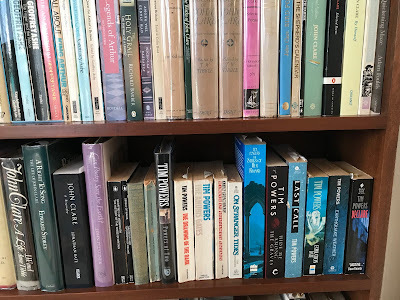
The Works of John Clare. Ed. Arthur Symons. 1908. Introduction by John Goodridge. The Wordsworth Poetry Library. Ware, Hertfordshire: Wordsworth Editions Ltd., 1995.The Poems of John Clare. Ed. J. W. Tibble. 2 vols. London: J. M. Dent & Sons Ltd. / New York: E. P. Dutton & Co. Inc., 1935.Poems of John Clare’s Madness. Ed. Geoffrey Grigson. London: Routledge & Kegan Paul, 1949.The Prose. Ed. J. W. & Anne Tibble. 1951. London: Routledge & Kegan Paul, 1970.The Letters. Ed. J. W. & Anne Tibble. 1951. London: Routledge & Kegan Paul, 1970.The Shepherd’s Calendar. Ed. Eric Robinson & Geoffrey Summerfield. Wood Engravings by David Gentleman. 1964. London: Oxford University Press, 1974.The Later Poems. Ed. Eric Robinson & Geoffrey Summerfield. Manchester: Manchester University Press, 1964.Selected Poems. Ed. J. W. & Anne Tibble. Everyman’s Library, 563. London: J. M. Dent, 1965.The Wood is Sweet. Ed. David Powell. Introduction by Edmund Blunden. Illustrated by John O'Connor. Poems for Young Readers. London: The Bodley Head Ltd., 1966.Bird Poems. Introduction by Peter Levi. Wood-Engravings by Thomas Bewick. London: The Folio Society, 1980.John Clare’s Birds. Ed. Eric Robinson & Richard Fitter. Illustrated by Robert Gillmor. Oxford: Oxford University Press, 1982.John Clare: The Oxford Authors. Ed. Eric Robinson & David Powell. Oxford: Oxford University Press, 1984.The Parish: A Satire. Ed. Eric Robinson. Notes by David Powell. 1985. Penguin Classics. Harmondsworth: Penguin, 1986.Selected Letters. Ed. Mark Storey. Oxford Letters & Memoirs. 1988. Oxford: Oxford University Press, 1990.Selected Poems. Ed. Geoffrey Summerfield. 1990. Penguin Classics. London: Penguin, 2000.John Clare By Himself. Ed. Eric Robinson & David Powell. Wood Engravings by Jon Lawrence. 1996. Fyfield Books. Manchester: Carcanet Press, 2002.For more on the subject, here are a few selections from the burgeoning library of books about him. I'd recommend, in particular, Jonathan Bate's groundbreaking biography: Tibble, J. W. & Anne. John Clare: A Life. 1932. Rev. Anne Tibble. London: Michael Joseph Ltd., 1972.Storey, Edward. A Right to Song: The Life of John Clare. London: Methuen, 1982.Bate, Jonathan. John Clare: A Biography. 2003. Picador. London: Pan Macmillan, 2004.Foulds, Adam. The Quickening Maze. 2009. Vintage Books. London: Random House, 2010.Felstiner, John. Can Poetry Save the Earth? A Field Guide to Nature Poems. New Haven & London: Yale University Press, 2009.
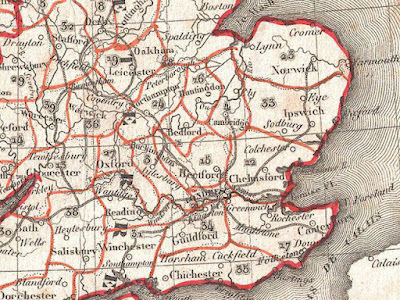 Rob Chapman: On the Trail of John Clare (2017)
Rob Chapman: On the Trail of John Clare (2017)•
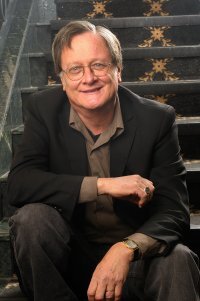 Tim Powers (2013)
Tim Powers (2013)& the Time to Cast Away Stones
Tim Powers' novels and stories are definitely an enthusiasm of mine. They have their limitations, but their strengths are equally obvious. You'll have to take my word for it that it's not as easy as it might seem to concoct complex and believable secret histories, mixing occult and quotidian phenomena in approximately equal measure. I am, after all, the author of a number of them (my 'REM' trilogy, for instance). Powers is a master of the art.
I've discussed my favourites among his books in my blogpost here, though a few more have appeared since I wrote it: notably the Vickery and Castine trilogy, which does a great job of mythologising the Los Angeles Freeway system, among other strange and arcane matters.
Here's a list of his major works to date (give or take a few limited-edition novellas):
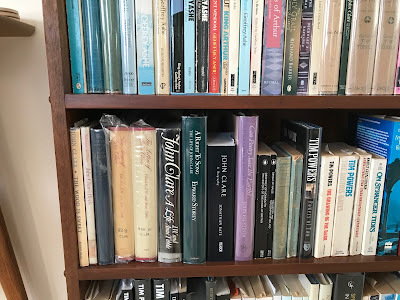
Powers of Two: The Skies Discrowned & An Epitaph in Rust. 1976, 1986, 1989. Framingham, MA: The NESFA Press, 2004.The Drawing of the Dark. 1979. London: Granada, 1981.The Anubis Gates. 1983. London: Triad Grafton Books, 1986.Dinner at Deviant's Palace. 1985. London: Grafton Books, 1987.On Stranger Tides. 1987. New York: Ace Books, 1988.The Stress of Her Regard. 1989. London: HarperCollins, 1991.Last Call. Fault Lines, 1. 1993. New York: Avon Books, 1996.Expiration Date. Fault Lines, 2. London: HarperCollins, 1995.Earthquake Weather. Fault Lines, 3. 1997. London: Orbit, 1998.Declare. 2001. New York: HarperTorch, 2002.Strange Itineraries and Other Stories. San Francisco: Tachyon Publications, 2005.Three Days to Never. 2006. William Morrow. New York: HarperCollins Publishers, 2013.The Bible Repairman and Other Stories. San Francisco: Tachyon Publications, 2011.Hide Me Among the Graves. 2012. Corvus. London: Atlantic Books Ltd., 2013.Medusa's Web. 2015. Corvus. London: Atlantic Books Ltd., 2016.Down and Out in Purgatory: The Collected Stories of Tim Powers. Preface by David Drake. Introduction by Tony Daniel. 2017. Riverdale, NY: Baen, 2019.Alternate Routes. Vickery & Castine, 1. A Baen Books Original. Riverdale, NY: Baen, 2018.Forced Perspectives. Vickery & Castine, 2. A Baen Books Original. Riverdale, NY: Baen, 2020.Stolen Skies. Vickery & Castine, 3. A Baen Books Original. Riverdale, NY: Baen, 2022.The critical literature on him is limited, consisting mainly of interviews and reviews in various journals. He isn't discussed directly in the K. K. Ruthven book cited below, but many of its contentions bear interestingly on his work: [Katz, Brad. “An Interview with Tim Powers (21/2/96).” Brow Magazine 1996.
http://www.mcs.net/~brow/powers.html]Ruthven, K. K. Faking Literature. Cambridge: Cambridge University Press, 2001.
 Karen Robinson: Los Angeles Freeway System Map (2013)
Karen Robinson: Los Angeles Freeway System Map (2013)•
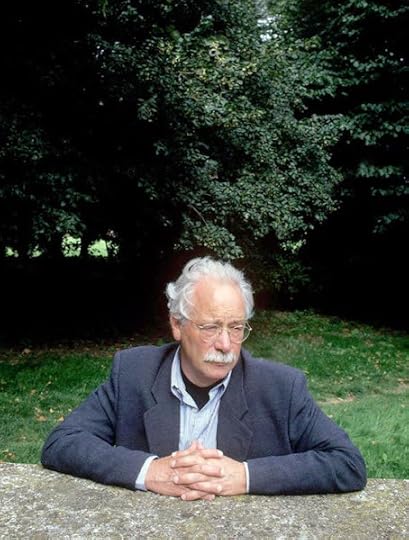 Basso Cannarsa: W. G. Sebald (2019)
Basso Cannarsa: W. G. Sebald (2019)& the Natural History of Destruction
W. G. Sebald is another one of those writers who seems unfairly singled out by fate for a brief flowering and then eternal night ("cum semel occidit brevis lux, / nox est perpetua una dormienda", [when once the brief light has set, / an eternal night must be slept], as Catullus put it in his much-quoted Elegy V). Hence, perhaps, the succession of books which has appeared since his death - perhaps in the hope of continuing his writing career from beyond the grave.
I've written more about this in my blogpost here, along with a few notes in a more recent post on The Imaginary Museum .
Is he a psychogeographer? It seems as good a description as any for his genre-defying works, part fiction, part non-fiction, part travel literature, part history lesson: in particular Vertigo and The Rings of Saturn, but also such eclectic essay collections as the recently translated A Place in the Country.
That's how I choose to regard him, at any rate, though I'm happy to hear all the reasons why I'm wrong from some more earnest commentator.
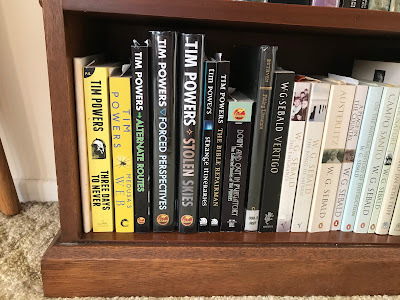
After Nature. 1988. Trans. Michael Hamburger. 2002. Harmondsworth: Penguin, 2003.Vertigo. 1990. Trans. Michael Hulse. London: Harvill Press, 1999.The Emigrants. 1993. Trans. Michael Hulse. 1996. London: Vintage, 2002.The Rings of Saturn. 1995. Trans. Michael Hulse. 1998. London: Vintage, 2002.A Place in the Country: On Gottfried Keller, Johann Peter Hebel, Robert Walser and Others. 1998. Trans. Jo Catling. 2013. London: Penguin, 2014.On the Natural History of Destruction: With Essays on Alfred Andersch, Jean Améry and Peter Weiss. 1999. Trans. Anthea Bell. 2003. Harmondsworth: Penguin, 2004.Austerlitz. 2001. Trans. Anthea Bell. 2001. Harmondsworth: Penguin, 2002.Campo Santo. Ed. Sven Meyer. 2003. Trans. Anthea Bell. 2005. Harmondsworth: Penguin, 2006.[with Jan Peter Tripp]. Unrecounted: 33 Texts and 33 Etchings. 2003. Trans. Michael Hamburger. Hamish Hamilton. London: Penguin, 2004.Across the Land and the Water: Selected Poems, 1964-2001. 2008. Trans. Iain Galbraith. Hamish Hamilton. London: Penguin, 2011.Carol Angier's biography speaks to the underlying anxieties of Sebald's life and times, and the curious ways in which this was manifested in his work. As in her previous book about Primo Levi, she does have certain hobby-horses which continually appear, but no-one could complain of any lack of contextual documentation for her views. Angier, Carol. Speak, Silence: In Search of W. G. Sebald. London: Bloomsbury Circus, 2021.
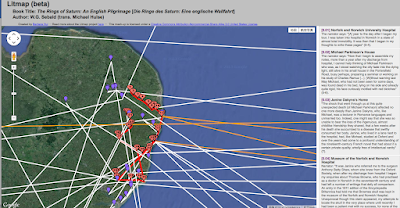 Barbara L Hui: Mapping Literature (2014)
Barbara L Hui: Mapping Literature (2014)•
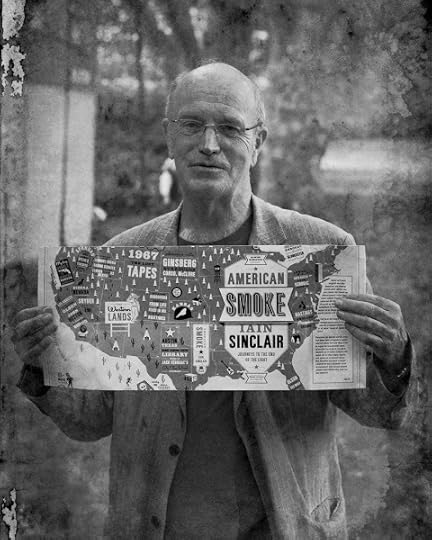 Iain Sinclair (2013)
Iain Sinclair (2013)& the Secret History of London
Iain Sinclair is certainly the most self-consciously psychogeographical of all the authors mentioned here. He began as a poet, then moved to writing novels, and then on to stranger works of cross-genre travel / history / art & film criticism. It's mostly these latter which have won him a cult audience.
He may lack the immediate visibility of a Peter Ackroyd or an Alan Moore, but his oeuvre could be argued to be at least as influential. I haven't yet written about him at length, as there a number of his books I'd like to read first, but I have compiled an approximate bibliography for him among the others included here
Here's a small selection from the poetry and fiction he's published to date:
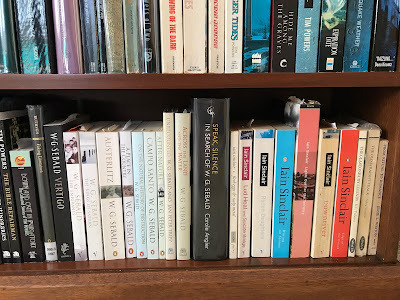
Lud Heat and Suicide Bridge. 1975 & 1979. Introduction by Michael Moorcock. Vintage. London: Random House, 1995.Flesh Eggs & Scalp Metal: Selected Poems, 1970-1987. A Paladin Paperback Original. London: Grafton Books, 1989.Downriver (Or, The Vessels of Wrath): A Narrative in Twelve Tales. 1991. Vintage. London: Random House, 1995.Radon Daughters. 1994. Vintage. London: Random House, 1995.Dining on Stones (or, The Middle Ground). 2004. Harmondsworth: Penguin, 2005.The non-fiction works listed below are where his greatest strengths lie, I would argue. I don't have a copy of his ground-breaking London Orbital: A Walk Around the M25 (2002), unfortunately, but I have read it with great interest, and indeed used to have a chapter from it as one of the readings in my Massey Travel Writing course. Lights Out for the Territories: 9 Excursions in the Secret History of London. London: Granta Books, 1997.Edge of the Orison: In the Traces of John Clare's 'Journey Out of Essex'. 2005. London: Penguin, 2006.
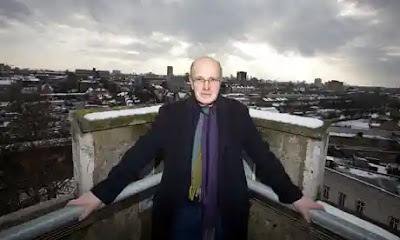 Karen Robinson: On the Road (2004)
Karen Robinson: On the Road (2004)•
Here and there on this blog you can find some of my own attempts at a psychogeography of my own whereabouts, in the form of the two (hopefully ongoing) series "The Intrepid Ghost-Hunters" and "The Mysteries": The Intrepid Ghost-Hunters (1): Waitomo Caves (13/11/2012)The Intrepid Ghost-Hunters (2): Thames & Te Aroha (13/8/2013)The Intrepid Ghost-Hunters (3): Home Turf (5/8/2015)The Mysteries of Ashburton (25/1/2019)The Mysteries of Rotorua (28/4/2019)The Mysteries of Auckland: H. P. Lovecraft (12/4/2021)The Mysteries of Auckland: Jules Verne (4/7/2021)
•
In any case, it's nice to see all these books gathered together for the first time. I can feel them already starting to talk among themselves. I doubt very much that this is the last that I'll have to say on the topic, either.
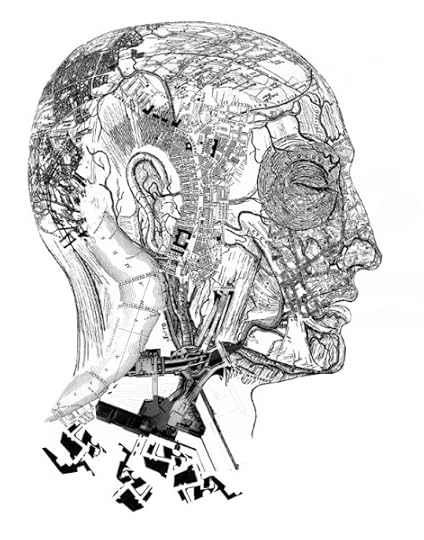 Robert Macfarlane: Psychogeography (2019)
Robert Macfarlane: Psychogeography (2019)
Published on May 31, 2022 16:07



